
ESL
Seminars™
Preparation Guide
For The
Test of Spoken English
®
And Some IELTS
®
Material
ESL Seminars™ is not affiliated with, nor is it endorsed by, the Educational Testing Service®, creators and
administrators of the Test of Spoken English® exam. All material contained within this booklet, with the exception of
the sample questions provided by Educational Testing Service®, is the product of the creative minds of
ESL
Seminars™ staff. This material is presented as a guide to effectively prepare non-native English speakers to pass
entrance exams as part of a visa screening process. This material is primarily intended to be used as a class guide in
conjunction with
ESL Seminars™ Interactive Participation™ techniques. Copyright ©2003 by James A. Rarick.
All rights reserved. May not be copied in part or in whole except for review purposes.

2
© 2003
ESL Seminars™
. All Rights reserved. No part of any
ESL Seminars™
material may be copied without express written authorization by
ESL
Seminars™
officials.
ESL Seminars™
are not affiliated with Educational Testing Service® (ETS®) and are not endorsed by them.
ESL Seminars™
offers no guarantees with it’s materials.
Table of Contents
Introduction....................................................3
If You Always Do..........................................4
Scams.............................................................4
What Do You Need To Pass The TSE?.........5
What Are The General Goals?.......................5
Same Old Thing.............................................5
Pitfalls To Avoid............................................6
Tense and Storytelling...................................6
Using Short Sentences...................................7
And & Or = Never.........................................8
Pronouns........................................................8
Possessive Pronouns......................................8
Pop Quiz #1...................................................9
Impromptu Speeches.....................................9
A, An, The or (nothing).................................10
Short Exercise................................................10
Group Exercise..............................................11
Hot Tips #1....................................................11
Hot Tips #2....................................................11
Hot Tips #3....................................................12
Hot Tips #4....................................................12
Truths #1........................................................13
Truths #2........................................................13
Pop Quiz #2...................................................14
Pop Quiz #3...................................................15
Pop Quiz #4...................................................16
Pop Quiz #5...................................................17
Pop Quiz #6...................................................18
Pop Quiz #7...................................................19
Pop Quiz #8...................................................20
Pop Quiz Answer Key...................................21
TSE Sample Question Responses..................22
The Four New TSE Questions (2003)...........28
New Questions Sample Responses................31
Some Gentle Admonitions.............................34
What Kind of English
Do You Need To Speak
To Pass the TSE®......................................35
Words Are Your Tools..................................39
The Best Speaking Tool
Is Listening................................................40
If You Don’t Know
The Answer, Be Brave
Enough To Say So!....................................41
Who? What? Where?
When? How?.............................................42
Troublesome Words.......................................43
Gender............................................................44
Plain Language Strategies..............................45
Other “Strategies”..........................................48
Internet Resources..........................................49
Consider Your Fortunes ................................50

3
© 2003
ESL Seminars™
. All Rights reserved. No part of any
ESL Seminars™
material may be copied without express written authorization by
ESL
Seminars™
officials.
ESL Seminars™
are not affiliated with Educational Testing Service® (ETS®) and are not endorsed by them.
ESL Seminars™
offers no guarantees with it’s materials.
Introduction
Reference Points
We all know what accents are when discussing language. People from the east, west, north, and south of your country
probably speak a different variations of the predominant language. The same is true with American English. Folks from
Louisiana speak differently than those from New Hampshire. Texas accent is much different than New York accent, and so
on and so on.
What does this have to you or with the TSE®? A lot! The goal of our seminar service, and these materials, is to prepare you
to pass the TSE®. To do that you must speak American style English with as neutral an accent as possible. You must develop
speech patterns that make you appear to be from Chicago, Indianapolis, Minneapolis, or any number of Midwestern
American cities. Is that all you need to do? No. Of course not. The whole issue of passing the TSE® exam can appear to be
a terribly complicated matter. One of our tasks is to simplify that process for you.
There are Limits To Our Seminar
If you intend to pass the TSE® you must practice, practice, and then practice some more to make your verbal responses
mimic American style English. You must use our materials as intended, and you must also attend the
ESL Seminars
if
you are at all able to do so. In any event, if you use one of your own fellow country persons to instruct you along the way,
or if you use one of your local “refreshers” or “reviews” along with our materials, do not blame us for any failures. We have
stated since our inception that an Indian cannot teach another Indian to speak American style English. A Filipino cannot
teach another Filipino to speak American style English. Our “secret weapon” is our American guest speaker who gives you
immediate and effective feedback of your spoken English. That is how we get you to pass the TSE® exam. Your local
“refreshers” and “reviewers” will only counteract our efforts on your behalf.
What Are The Speaking “Secrets”?
There are no “secrets”, per se. It is only common sense. You will learn from us to speak in a measured fashion, to use short
sentences, and to speak directly to the point. If you are from the Philippines, India, or most any Asian country, your normal
speech rate is far to fast to be easily understood. Even a very thick, or heavy, accent can be understood if the words are
spoken in a measured manner, with each word spoken clearly, with the correct pronunciation.
Once I Know How To Speak, What Do I Say?
The questions that will be posed to you in the TSE® exam are what you would normally encounter during conversations
with colleagues, friends, or family. It is conversational American style English. You will be asked to describe things. You
will be asked to give directions. You will be asked to critique and correct things you will listen to. The tasks are nothing out
of the ordinary. If you are fully aware of exactly what is being asked of you, you should have no problem handling the
questions. The key is to be totally aware of what the question is. To do that, you must learn to listen very well.

4
© 2003
ESL Seminars™
. All Rights reserved. No part of any
ESL Seminars™
material may be copied without express written authorization by
ESL
Seminars™
officials.
ESL Seminars™
are not affiliated with Educational Testing Service® (ETS®) and are not endorsed by them.
ESL Seminars™
offers no guarantees with it’s materials.
ESL Seminars™
Hello! My name is James Rarick and I have written this seminar
guide to hopefully give you some insight into how to pass the Test
of Spoken English® (TSE®). I hope that most of you have read
my biographical data. If not, the short version is that I am a
Graphic Communications graduate and have taught Graphic
Communications in a college setting. I am a published author and
hope to have a second book out sometime within the next year. I
also worked for nearly 20 years as a supervisor and Director at one
of the world’s most secure maximum-security prisons.
Our materials were originally developed for the Philippines and
Indian market. Most of the place or object references in our
seminar and in our seminar materials are of Philippine origin. We
are not biased toward any certain culture, religion, etc. Our only
bias is to get you to pass the TSE® exam.
At this point I would like to congratulate all of you for being
college graduates and highly trained professionals. I believe that
all of you have taken and passed the other TOEFL® exams and
have a good understanding of the technical aspects of the English
language. Unfortunately, that wonderful technical understanding
of English that you possess does not give you an advantage in
spoken American style English.
Some ground rules for our two-day seminar and for reading our
materials:
• With most of you being health-care professionals, I will
just assume that you know that the mind can only absorb
what the posterior can endure. That being said, if any one
of you feel the need to get up and stretch your legs or
visit the C.R., please do so at your convenience. Mark
your place in this book and come back to it later. I do
encourage you to not skip any of this book. The informa-
tion is valuable and time is short.
• Second, network with other individuals who will also be
taking the TSE®. Networking is simply introducing
yourself to someone you don’t already know and ex-
changing business cards, or names/addresses, or email
addresses, etc., with them. The purpose of networking is
so that you might contact each other and work together,
preferably just before your scheduled TSE exam.
• Third, you should give a very short (one to two minute)
verbal dissertation on any of the TSE sample exam
subjects. Intersperse these English-speaking tasks along
with written exercises. No one need feel embarrassed to
speak publicly. It is a necessary exercise to help you
speak American English as if you were a native speaker.
You will need a tape recorder to capture what you are
saying and to compare it with a true American English
speaker.
The materials in this booklet repeat from time to time. That is by
design.
If You Always Do …
The real quote is: “If You Always Do What You Always Did, You
will Always Get What You Always Got!”
What that means is: If you have failed the TSE®, after taking
“refresher” courses on the same material you learned initially,
taking those same “refreshers” will only get you what you got
before: A failure! This seminar is a fresh look at the TSE®, not
a refresher of the same old thing. We will not dwell on the basics
of the English language but we will include some basic English
language exercises. We will focus on how to speak the English
language concisely, precisely, and with authority. One important
thing you will need to do is: Forget most, if not all, of what you’ve
learned in other “refresher” courses.
Make no mistake; our seminar and our materials are tailored to
prepare you totally and completely so you are able to pass the
TSE® exam.
Scams.
Just a few words on scams you might encounter. There are any
number of “recruiters” out there willing to make you all kinds of
promises and will give you visions of something for nothing.
Don’t believe them!
Let’s dispel some myths:
• Superman does not exist.
• The streets in the USA are not paved with gold.
• Health care and other recruiters that say: “you do not
have to pass TOEFL® and TSE®” are lying!
• To practice as a nurse or any other type of professional
in the USA or Canada you must pass proficiency tests in
English. You will also be required to pass state board
exams in the state or province in which you work. That
is a fact – not a myth!
What I am trying to say to you is to be very, very careful. There
are plenty of scams out there that can, at best, steal your money
and, at worst, can put you in physical harm.
A short story: Back in the early 1900’s there were many immi-
grants coming to the USA from Germany. It has been said that

5
© 2003
ESL Seminars™
. All Rights reserved. No part of any
ESL Seminars™
material may be copied without express written authorization by
ESL
Seminars™
officials.
ESL Seminars™
are not affiliated with Educational Testing Service® (ETS®) and are not endorsed by them.
ESL Seminars™
offers no guarantees with it’s materials.
when one German fellow arrived in New York he immediately
got off the boat and started walking down a New York street. He
noticed a $100 bill lying on the pavement in front of him. He
reached down to pick it up but then suddenly straightened up
without retrieving the money. He smiled brightly and said to
himself: “Hey, this is just my first day in the USA. Why should I
start working right away?”
Believe me, that is not the way it is in the USA or any other place.
You have to work for your money; You do not pick it up off the
streets. If a recruiter promises something for nothing run away as
fast as you can!
What do you need to pass the TSE?
What you need is the ability to tell stories nearly as well as a
native English-speaking person. I say “nearly” because the test
reviewers know full well you are not a native English speaker.
The task isn’t necessarily easy. On the other hand, it is not all that
hard. As I mentioned before, you have already mastered the
technical aspects of the English language. You undoubtedly know
more about the English language from a clinical, or technical,
standpoint than I. You have passed the TOEFL® exams and I
have not. On that score you are one up on me.
However, you need to be able to communicate those English skills
in a verbal manner. That is something that can be difficult for
those whose native culture has no gender usage to speak of and
where “shortcuts” are common.
Just this morning I asked my LDW (that stands for Loving
Devoted Wife) where the C.R. was. What I got back from her was
this (pointing with lips, eyebrows raised). That’s a shortcut and is
definitely not a verbal way to communicate. One other custom I
see in the Philippines is that of taking one’s hands and extending
it in front of the body to demonstrate to people that the person
wants to pass through. You will have to learn to say, for example:
“Excuse me, I am trying to get to the elevator.” You must get into
the habit of communicating verbally, in a clear and direct manner.
You can do that in your native language. It will still help you with
your spoken English
Once again, the objective in being able to pass the TSE® is to
speak clearly, with authority, and precisely to the task assigned.
You must also speak in an American-style English. For those of
you with a mathematics background you can apply some of the
algebraic logic you possess. Make your thoughts complete and
linear. By linear I mean you must speak from the starting point of
the assignment directly to the end without diverging.
What are the general goals of
ESL Semi-
nars?
1. To prod all of you to think about the TSE® questions in
a linear and logical fashion.
2. To have you speak English clearly, without hesitation, in
an American style, when taking the TSE® exam.
3. To use the correct gender in your sentences.
4. To implement the correct verb usage.
5. To implement the correct tense.
Of those five, I believe that gender and tense usage, along with the
American style of English speaking, are probably the most impor-
tant. Because you have grown up in a culture where gender usage
is not a factor in the spoken language, it has been my observance
that it is easy to unconsciously switch between his, hers, he, she,
etc., without regard to the gender of the person you are speaking
about.
You will all need to become extremely gender conscious. In a
health-care setting it is critical (you don’t want your co-workers
to set up a birth delivery room for a man you keep referring to as
“she”). In passing the TSE it is very critical that you become
aware of gender.
I should have stated this from the start but at least it’s not too late
to do it now: Please take notes in your class materials to remind
you of points made by the presenters during this two-day seminar.
Clear notes will serve you well in the future to recall your
thoughts. There is also an extremely strong bond between writing
things down and retention of the material you are trying to learn.
Same Old Thing + Same Old Thing
= Same Old Thing
If you have taken the TSE® exam before, and you failed, you
must have pondered why you did fail. We believe in most cases
that it had to do with preparation and your previous lessons, not
with you. Remember that – you are not the fault. Of course, you
are the one that actually failed the test, but you did not formulate
the preparation. As the title says: “Same Old, Same Old”. If you
were not prepared well, you could not succeed. If you take
“refreshers” from the same material you should expect to have the
same results every time – FAILURE.
If you complete our seminar and for some reason you fail the
TSE® you can come back and take the seminar again with no fee
whatsoever. It is our belief that the failure, if it happens after you

6
© 2003
ESL Seminars™
. All Rights reserved. No part of any
ESL Seminars™
material may be copied without express written authorization by
ESL
Seminars™
officials.
ESL Seminars™
are not affiliated with Educational Testing Service® (ETS®) and are not endorsed by them.
ESL Seminars™
offers no guarantees with it’s materials.
take our seminar, is due to your not absorbing the material. It
could also be your trying to take our material and fitting it to what
you learned before. That won’t work. We give you the tools but
we can give no guarantees. There are no guarantees in life!
Take our material at its face value. That means you should clear
your mind and try to view the task of passing a 20-minute test as
an adventure, not a dreaded event. We can get you to pass the test.
Believe in us and focus on our message! Utilize our tips, hints,
and techniques fully!
Pitfalls to avoid!
This is one subject you might consider taking ample notes of.
There are many traps that will cause you to fail the TSE. The
TOEFL Monograph Series by Lazaraton-Wagner point out
many of them that you must watch out for. To overcome tenden-
cies to make these spoken English errors takes practice, lots and
lots of practice. If you can find an American or an English person
to practice with would be the best. They should be prepared to
critique your speech and to help you overcome any inclination to
do the following:
1. Hesitation or periods of silence in your storytelling (use
complete sentences and follow the order of events as
listed in the question or the picture you are interpreting).
You must make use of the preparation time given you
during the exam to collect your thoughts in a complete
and linear manner.
2. Lengthening the sound of a word (which usually hap-
pens when you are trying to collect your thoughts in
mid-sentence – collect your thoughts before speaking).
This is a repair technique used unconsciously when the
mind goes blank.
3. Not using the correct (or not using any) intonation.
When denoting the end of a sentence that has a period the
voice should fall away. When denoting the end of a
question (question mark [?]) the voice intonation should
rise. Commas (,) should have just a short break in the
voice intonation. Sentences with an exclamation point
(!) should have an animated voice.
4. Running sentences together (if there is a period [.] the
voice should clearly end before starting with the next
sentence, etc.). This is also the product of talking too
fast. Slow down and be heard clearly!
5. Uttering unintelligible words (use only words you can
correctly pronounce and never use words that are above
your level of understanding). Don’t let your brain pick
out a word that your mouth can only mumble.
6. Speaking in a creaky voice, a too-soft voice, or a pat-
tern of speech that speeds up and slows down notice-
ably (speak in a clear tone with a measured cadence).
7. Wrong diction. You must learn to pronounce words as
native American English speakers do.
Emphasize the correct syllable.
I would like all of you to take note of how I speak to you on our
CD’s. If you can emulate or imitate my speech styles so much the
better – especially my diction. I imagine that I could not compare
with any of you in your mastery of the TOEFL® exams but I also
imagine that I could pass the TSE® with flying colors. It is the
subtle techniques of spoken American style English that you need
to pick up on. Please pay close attention to those techniques.
As I mentioned to you before – use a tape recorder, if at all
possible, to record your verbal answers to the sample TSE®
questions. Note if you commit any of the pitfalls I just described
previously when you listen to your recording. Work hard to
overcome those pitfalls. Once you have improved your spoken
American style English techniques to your complete satisfaction,
pass on the tape to a friend for them to critique. It is not enough
to satisfy yourself, you have to have critique from others.
Tense and storytelling.
Tense is very important in storytelling. Tense usage must remain
constant and relevant throughout your story. There should be no
need to do an academic review of what tense is. I will assume that
you all know what I am speaking of. I would like you all to
complete the short assignment on this page and we will discuss it
when you have completed. You have 10 minutes to complete the
following:
Identify the tense of each sentence and change it to simple
present.
1. Did you like Beijing? Tense? __________ Re-write:
_____________________________________
2. It has been raining very heavily. Tense? __________ Re-
write: _____________________________
3. We are working hard. Tense? __________ Re-write:
______________________________________

7
© 2003
ESL Seminars™
. All Rights reserved. No part of any
ESL Seminars™
material may be copied without express written authorization by
ESL
Seminars™
officials.
ESL Seminars™
are not affiliated with Educational Testing Service® (ETS®) and are not endorsed by them.
ESL Seminars™
offers no guarantees with it’s materials.
Identify the tense of each sentence and change it to simple
past.
1. I am a graduate student at a large University. Tense?
__________ Re-write:
________________________________________________
________________
2. I was working in a large oil company. Tense? __________
Re-write:
________________________________________________
________________
3. I had finished the project in plenty of time. Tense?
__________ Re-write:
________________________________________________
________________
4. We have gone there many times before. Tense? __________
Re-write:
________________________________________________
________________
Identify the tense of each sentence and change it to present
continuous.
1. I boiled the water to make tea. Tense? __________ Re-
write: _____________________________
2. I meet lots of interesting people at my new job. Tense?
__________ Re-write:
________________________________________________
________________
3. I had mailed the letter before starting to eat. Tense?
__________ Re-write:
________________________________________________
________________
Change each sentence from simple past to past continuous.
1. I did it all that day. Re-write:
________________________________________________
_______
2. The most rain occurred during summer. Re-write:
______________________________________
3. The theatre showed three movies a day. Re-write:
______________________________________
Identify the tense of each sentence and change it to present
perfect.
1. It is blistering hot today. Tense? __________ Re-write:
__________________________________
2. Vicki and Jim were married in September. Tense?
__________ Re-write: _____________________________
Now, review your answers and do some additional impromptu
speeches into your tape recorder.
Using Short Sentences.
When speaking in English, please keep your sentences short and
concise. Developing compound or complex sentences in your
mind while storytelling could cause you to pause unintentionally
or otherwise mar your TSE® exam.
Just remember:
KISS –
Keep It Simple, Scholar! The last “S”
used to be “Stupid” but none of you here today fit that descrip-
tion.
Break your story down into short, easily pronounced sentences,
with correct verb, gender and tense usage. It sounds complicated
but it really is a simplification.
Keep in mind that the TSE® exam takes only about 30 minutes
to complete. Of those 30 minutes you will be speaking only 10 to
12 minutes. Twelve minutes is a very, very, short time. That
makes all the more reason to use short sentences. You can actu-
ally get more information packed into those few minutes by using
short sentences than you can by using difficult to understand,
long, and complicated sentences.
You will be expected to speak as a college-educated professional
during the TSE® exam. It appears to me that the most difficult
parts have already been addressed. You are all college graduates
and you are all professionals in your chosen field.
But, back to short sentences. Read out loud the following exam-
ples
Example 1:

8
© 2003
ESL Seminars™
. All Rights reserved. No part of any
ESL Seminars™
material may be copied without express written authorization by
ESL
Seminars™
officials.
ESL Seminars™
are not affiliated with Educational Testing Service® (ETS®) and are not endorsed by them.
ESL Seminars™
offers no guarantees with it’s materials.
• I took a drive with John, who used his older Jeepney, the
one with blue paint and a broken headlight, and he drove
much too fast to Ulas, which was our final destination.
(Compound sentence)
• I took a ride with John. He used his old blue Jeepney.
The Jeepney had a broken headlight. John drove much
too fast for my comfort. It was 4:00 p.m. when we
arrived in Ulas. (Short sentences)
Example 2:
• Bing and Joy went to the Registrar’s office at San Pedro
College to register for their classes at 9:30 last Tuesday
morning and found that the office was empty and they
could not register. They waited for nearly 2 hours until
they realized that the office was closed on Tuesdays and
that they might have to come back the next day to
register for the four classes each of them wanted to take.
• Last Tuesday Bing and Joy walked to San Pedro Col-
lege. They were going to register for classes. When they
reached the Registrar’s office they found it closed. They
decided to wait until it opened. After waiting two hours
they realized the office was closed on Tuesdays. Both
Bing and Joy came back on Wednesday to the
Registrar’s office. They each then registered for four
classes.
Which sounds better for each example? Of course, the shorter
sentences sound better and are understood easier.
And & Or = NEVER!
To keep your sentences short, avoid the words “and” and “or” at
all costs. Many times their use is unavoidable but don’t use them
to lengthen sentences. The object is to shorten your sentences.
Pronouns.
Please circle your choice of pronoun on each of the following
sentences. Class discussion will follow.
1. Despite her parents’ complaints, she decided to live by
her / herself in New York City.
2. If you happen to see your parents this weekend, give
him / her / them my best regards.
3. I can’t understand her / me when she speaks German
with him / me.
4. He should be ashamed of himself / him.
5. Mary was worried about the children, so she convinced
his / her husband not to accept the job abroad.
6. We came across a friend of ours / us at the mall yester-
day.
7. I can’t find my / your pencil. Can I use mine / yours,
Mary?
8. I cut me / myself when I was peeling the potatoes.
9. This house is too expensive for us / we. We can’t pay
such a high rent.
10. Each plan has it / its merits.
11. He his self / himself said so.
12. I do my work and they do their / theirs.
13. Give it back to me / my. It’s me / mine.
14. Despite his / her old age, Jim is very active.
15. They enjoyed their selves / themselves a lot at the
cocktail party.
Possessive Pronouns
Please write in your choice of pronoun on each of the following
sentences. Class discussion will follow.
1. It belongs to me, it’s _________.
2. It belongs to my father, it’s __________.
3. It belongs to her, it’s _________.
4. It belongs to Mr. and Mrs. Smith, it’s _________.
5. It belongs to my wife and me, it’s _________.
6. It belongs to my mother, it’s _________.
7. It belongs to him, it’s _________.
8. It belongs to you, it’s _________.
9. It belongs to the dog, it’s _________.
10. It belongs to him, it’s _________.

9
© 2003
ESL Seminars™
. All Rights reserved. No part of any
ESL Seminars™
material may be copied without express written authorization by
ESL
Seminars™
officials.
ESL Seminars™
are not affiliated with Educational Testing Service® (ETS®) and are not endorsed by them.
ESL Seminars™
offers no guarantees with it’s materials.
11. John Anderson forgot ________ book.
12. Mary and Susan talk like _________ mother.
13. Alex and I were late for _________ class.
14. Pres. Arroyo was wearing _______ new Gucci gown.
15. Where are ________ keys? I can’t find them.
16. Where do you keep _________ money, in the bank?
17. Everyone should bring __________ signed receipt.
That was a good exercise. Now we are going to do some other
things.
The instructions are simple for this next exercise: Read the ques-
tions carefully and quickly before completing the test. You have
only 60 seconds to complete the task.
Pop Quiz #1
Listen to the verbal instructions from the presenter. Follow them
carefully. You will have only 1 minute to complete this quiz.
1. What is the capital of your native country?
_______________________
2. How many months are there in a year?
____________________
3. What is the third month of the year?
_____________________
4. Who is the current leader in your native country?
_____________________
5. 12 times 12 equals a “gross”. How many items equal a gross?
__________
6. Who is the current Mayor of your native town?
________________________
7. What city in the world is actually the largest city in the world?
______________
8. Do not answer any of the numbered questions on this page.
_________________
9. Only print your name and the current date at the top of the
page. _______________
10. After writing your name and the date, put your pen down and
wait. ______________
Who answered any of the questions? How many did you answer?
The object of this exercise was to measure how well you listened
to, and followed, the verbal instructions given you. If you had
read all of the questions you would have realized that all that was
expected is that you write down your name and the current date
on the page. You were then to put your pen/pencil down and wait
for me to begin speaking again. Those that answered any ques-
tions clearly did not listen or read well and assumed something
that did not exist.
One observation about the word: assume. It can be divided into
three pieces. To assume means that you will make an ASS out of
U and ME. Do not assume anything. If you do have to assume
make sure that you put it into context. For example: See the TSE®
test answer examples located on other pages of this publication.
For future projections on the graph picture in the sample test you
are asked questions about the future. You will have to “assume”
future events based on past experience. When you make those
assumptions you will state that they are just that, assumptions, and
not factual information.
Impromptu Speeches.
For this time segment, pick out various subject matters, such as
how to cook rice, how to drive a car, etc. Take a few minutes to
compose your thoughts, and then give a short (one to two minute)
speech on the subject matter. Make sure you record your spoken
English. Then critique the speeches.
However, before we start, I will relate a story about a friend who
belongs to the Toastmasters. Does everyone know what the Toast-
masters are? Good. Well, this short story will illustrate the dan-
gers of miscommunication and assumption.
Not long ago my friend was at his regular Toastmaster
meeting. As you might know, at each meeting one per-
son is selected to give an impromptu 10-minute speech
on a subject they are not prepared for. Well, my friend
was the one called on this particular night. The subject?
Human Reproduction. In short, the subject was sex.
My friend gathered his thoughts and then launched into
the most brilliant speech ever witnessed at a Toastmas-
ters gathering. He was magnificent. He addressed the
social, religious, and technical aspects of the subject. He
was masterful!

10
© 2003
ESL Seminars™
. All Rights reserved. No part of any
ESL Seminars™
material may be copied without express written authorization by
ESL
Seminars™
officials.
ESL Seminars™
are not affiliated with Educational Testing Service® (ETS®) and are not endorsed by them.
ESL Seminars™
offers no guarantees with it’s materials.
After the meeting he immediately went home. At his
house he prepared for bed. His wife, already in bed,
asked him how the meeting went. He replied “Fine” and
stated that he was the one picked for the impromptu
speech. His wife asked what the subject was. Not want-
ing to initiate a long discussion, and feeling just a little
awkward, he told a “white” lie and said, “Oh, it was
about aviation. How to pilot an airplane.” His wife
thought that was a little odd, but didn’t say anything
more. They both dozed off for a good night’s rest.
The next morning my friend’s wife went to the market to
do some shopping for groceries. At the market she met
with three female friends that just happened to belong to
the same Toastmaster’s club as her husband. Assuming
she knew what her husband had talked about, they ap-
proached my friend’s wife and told her (along with some
winking and big smiles) that her husband’s speech had
been letter perfect and that she was a lucky woman to be
married to him. The three women giggled a lot!
My friend’s wife seemed perplexed and she motioned
the other women closer. “You know,” she replied, “I will
tell you frankly, as his wife … he doesn’t know a thing
about it!”
She went on: “In fact, he has only done it twice in his
lifetime. Once before we were married and once after-
ward.”
“The first time he got sick to his stomach. The second
time his hat blew off!”
At that the three ladies fainted.
Now, I would like all of you to understand why you should be
working heavily on speech exercises with friends and acquain-
tances. It can be summed up in three very short sentences:
Tell me and I’ll forget.
Show me and I might remember.
Involve me and I’ll understand.
A, An, The or (nothing)
This is a written exercise to determine which article is correct for
the sentence.
1. This is Bob. He’s a / an doctor.
2. Peter is a / an engineer.
3. That’s Oliver. He’s a / an travel agent.
4. Leonardo di Caprio is a / an actor.
5. Fred is a / an electrician.
6. Mr. Smith is a / an teacher.
7. This is Gloria. She’s a / an homemaker.
8. That’s John. He’s a / an police officer.
9. I’m a / an student.
10. Meryl Streep is a / an actress.
For the following, please write in the correct word (A, An, The,
or [nothing]).
1. This coat was designed by _______ famous New York
artist.
2. Can you tell me how to get to ______ bank from here?
3. ______ city museum is closed today.
4. He is one of ______ smartest people I know.
5. I recommend you eat _______ apple pie at this restau-
rant.
6. _______ milk is good for you.
7. Would you like to see _______ movie?
8. _____ apple a day keeps ______ doctor away.
9. I can’t believe I failed _______ yesterday’s test!
10. Do you have ______ dictionary that I can borrow?
A Short Exercise To Ease The Tension
Please write in the correct word (hint: or words) on each of the
following sentences. (This is not multiple choice – you have to
determine the correct word on your own. Oh boy, maybe the
tension will be back!)
Juan was born on a little farm in Leyte. He was happy
even though he __________ a hard life cultivating his

11
© 2003
ESL Seminars™
. All Rights reserved. No part of any
ESL Seminars™
material may be copied without express written authorization by
ESL
Seminars™
officials.
ESL Seminars™
are not affiliated with Educational Testing Service® (ETS®) and are not endorsed by them.
ESL Seminars™
offers no guarantees with it’s materials.
poor fields. One day he ___________ by a heavy thun-
derstorm. When the storm _____________ he
__________ saw that his plantation
___________________. He ____________ despondent
and ___________ that he could no longer live on the
farm. He _________ to move somewhere else. He
__________ the farm and ___________ to Manila. The
hustle and bustle of the city _______________ Juan a
lot, but he ______________ to go back to his farm.
Juan’s life in the city was very difficult. The only per-
son he _____________________ was Tomas, a distant
relative, who was a very patient and understanding per-
son who ___________ to help Juan to get used to
____________ in the city.
That was a good exercise. Now please do some additional
speech making into your tape recorder.
Group Exercise
English Language Arts.
You will need a group of people to perform this exercise. I
suggest at least four persons.
Goal: Students will learn to develop a verbal presentation, ar-
range sales and marketing arguments, and present a lucid
“commercial” to the class.
Materials needed: Paper and pen/pencil.
Please break into a group of 4 or more.
The group will be allowed 10 minutes to develop a commercial
that they will simulate giving on radio. Each group member will
be expected to verbally participate.
Subject matter: The product “Noodlelite”. Noodlelite is a prod-
uct constructed of macaroni that is designed to hold liquids.
Unfortunately, tests have shown Noodlelite to have one serious
drawback: It leaks when the macaroni gets wet. Nevertheless, the
production areas have proceeded with production and we now
have many warehouses full of Noodlelite. We need to sell it off,
even at a loss, in order to regain some of our capital.
Tasks:
1. Describe the supposed advantages of Noodlelite.
2. Discuss the drawbacks, or flaws, of Noodlelite but do
so under flattering conditions.
3. Suggest a need by consumers for this product.
4. Give a sales pitch designed to sell off the entire product
in the warehouse.
At the end of 10 minutes we will begin the “radio” commer-
cials with each member of the group presenting part of the
commercial.
Hot Tips #1
Slow Down, I Can’t Keep Up!
Too fast a talker is usually a hyper person – a type-A personality.
Fast talkers alienate people because they are so difficult to under-
stand. Slow down, take a measured pace! Aim for no more than
70 words per minute.
Aren’t You Done Yet?
Belaboring your points, or talking too slowly or monotonously
tends to make the listener “tune” you out. Make sure you talk fast
enough to retain the reviewer’s interest but make sure you leave
“spaces” between your words and make sure to vocalize punctua-
tion. Don’t put them to sleep! Make your point and be done with
it. Don’t go on and on about the same point.
The Rain In Spain Falls Mainly In The Plain
Be articulate and pronounce words correctly. If you consistently
pronounce words like “Propane” as profane, don’t use that word.
Locate an AMERICAN English dictionary and read it often.
Make sure you read the pronunciation guide, not necessarily the
spelling or the meanings
Hot Tips #2
Defensive Breathing
When we are nervous – or, more commonly, when we don’t know
how to breathe properly – several things can happen.
1. Our inability to focus and think calmly is impaired.

12
© 2003
ESL Seminars™
. All Rights reserved. No part of any
ESL Seminars™
material may be copied without express written authorization by
ESL
Seminars™
officials.
ESL Seminars™
are not affiliated with Educational Testing Service® (ETS®) and are not endorsed by them.
ESL Seminars™
offers no guarantees with it’s materials.
2. We begin to gasp for air because we have difficulty
catching our breath as we speak, causing the TSE re-
viewer to perceive us as uncontrolled and desperate.
3. Without proper breath control, our voice sounds shaky
and tremulous, leaving the TSE reviewer to view you as
nervous, tentative, or unsure.
4. Finally, improper breath control can maintain, or esca-
late increased heart rate and blood flow, which can affect
the overall status of your health.
What Can Happen?
If you don’t breath properly the following things may happen:
• You may have trouble focusing and concentrating.
• You may be perceived as sounding desperate.
• You may be perceived as sounding nervous or tentative.
• Your heart rate may increase, thereby placing you in a
more agitated state.
What Can I Do?
The Relaxation Breathing Technique is the backbone for all
other breathing techniques.
There are three basic steps for relaxation breathing:
1. Breathe through your mouth only, sip in air for two sec-
onds.
2. Next, hold the breath of air for three seconds without
breathing.
3. Finally, exhale the breath of air through your mouth
slowly and deliberately for five seconds.
While doing this exercise, you must never move your upper chest
when inhaling, and your shoulders must be down, not raised or
hunched. All of the movement – the sipping in of air, the holding
of the air, and the release of air through exhalation – must take
place in the abdominal region. Why? The abdominal area is where
we use our muscles to breathe naturally. In fact, if you observe a
dog, cat, or small child you will clearly see that their abdominal
area goes in and out as they breathe.
Hot Tips #3
Vocal Health
OK, do not forget these tips. Make sure you save this one! These
tips help you remedy any speech and voice problems you might
have on the day of the TSE® exam.
• No Smoking!
• No Drugs (except prescription and still be careful of
them!!!)
• No Alcohol!
• Don’t sleep with your mouth open the night before.
• Don’t yell or scream (24 hours).
• Don’t talk loud over the telephone (24 hours).
• Don’t talk loud over background noise (24 hours).
• Don’t clear your throat.
• Don’t talk too much.
• Limit consumption of dairy products (Don’t use any!!!
They will cause nasal drainage and irritation.)
• Use throat lozenges whenever needed.
• Drink lots of water.
• Avoid spicy foods.
• Swallow often (instead of clearing your throat).
Hot Tips #4
I don’t want to hear you! (Annoying Speech Habits)
Let’s go over the certain speech habits that will annoy the TSE®
reviewer (and others). Make a conscious effort to remove these
habits from your speech (forever, not just for the TSE Exam).
• Mumbling, talking too softly.
• Talking too loudly.
• Monotonous, boring voice

13
© 2003
ESL Seminars™
. All Rights reserved. No part of any
ESL Seminars™
material may be copied without express written authorization by
ESL
Seminars™
officials.
ESL Seminars™
are not affiliated with Educational Testing Service® (ETS®) and are not endorsed by them.
ESL Seminars™
offers no guarantees with it’s materials.
• Fillers “um,” “like ah,” “you know,” etc.
• Talking too fast.
• Poor grammar, mispronouncing words.
• High-pitched voice.
• Accent and Diction. (This is nearly unavoidable but try
to reduce your native-language influenced diction to a
minimum.)
• Don’t talk too much – just what is necessary. Make
your point!
Truths #1
Rules For Being Human
1. You will receive a body. You may like it or hate it, but it
will be yours for your entire lifetime.
2. You will learn lessons all your life. You are enrolled in
a full time informal school called life. Each day in this
school you will have the opportunity to learn lessons.
You may like the lessons or think them irrelevant and
stupid. Nevertheless, they are lessons and they shape
your life.
3. There are no mistakes, only lessons. Growth is a process
of trial and error: experimentation. The "failed" experi-
ments are as much a part of the process as the experiment
that ultimately "works."
4. A lesson is repeated until learned. A lesson will be
presented to you in various forms until you have learned
it. When you have learned it, you can go on to the next
lesson.
5. Learning lessons does not end – ever! There is no part of
life that does not contain its lessons. If you are alive there
are lessons to be learned.
6. Other people are merely mirrors of you. You cannot love
or hate something about another person unless it reflects
to you something you love or hate about yourself. Learn
to forgive yourself and to forgive others.
7. What you make of your life is up to you. You have all
the tools and resources you need. What you do with them
is up to you. The choice is yours.
8. Your answers lie inside you. The answer to all of life's
questions lie inside you. All you need to do is look,
listen, and trust – in God and yourself.
Truths #2
Maturity. It is achieved when you:
• Know yourself.
• Ask for help when you need it and act on your own
when you don't.
• Admit when you’re wrong and make amends.
• Accept love from others, even if you’re having a tough
time loving yourself.
• Recognize that you always have choices, and take re-
sponsibility for the ones you make.
• See that life is a blessing.
• Have an opinion without insisting that others share it.
• Forgive others and yourself.
• Recognize your shortcomings and your strengths.
• Have the courage to live one day at a time.
• Acknowledge that your needs are your responsibility –
not other people’s.
• Care for people without having to take care of them.
• Accept that you’ll never be finished learning – you’ll
always be a work-in-progress.
• Set goals for yourself and work hard to achieve those
goals. Never lose sight of your goal!

14
© 2003
ESL Seminars™
. All Rights reserved. No part of any
ESL Seminars™
material may be copied without express written authorization by
ESL
Seminars™
officials.
ESL Seminars™
are not affiliated with Educational Testing Service® (ETS®) and are not endorsed by them.
ESL Seminars™
offers no guarantees with it’s materials.
Pop Quiz #2
This exercise is about Pizza and Comprehension. I hope you all
like Pizza. For general information, in the US nearly all Pizzas are
delivered to the home by automobile. Very few Pizza restaurants
have dine-in facilities, but this fictional story takes place in Davao.
“Perry’s Pepper Pizza Parlor,” Perry said, “may I help you?”
“Yes, I’d like to order a large pepper pepperoni pizza with hot
peppers and green peppers,” said the lady on the other end of the
phone.
“Is that all, ma’am? Asked Perry.
“Yes, but please put the hot peppers on half the pizza and the
green pepper on both halves.”
“Also, I’d like the pepperoni on the hot pepper part but not on
the green pepper part.”
“But didn’t you say you wanted the green peppers on both
parts?”
“That’s right,” the lady replied.
“That’s not possible!” Perry pronounced.
“Why can’t I have green peppers on the whole pizza?”
“I mean the pepperoni part.”
“I don’t see why pepperoni placement is so difficult,” the lady
said. “But if that’s too much trouble, just put the pepperoni on
the whole pizza!” she added impatiently.
Perry sighed. “That will be 600 Pesos.”
“Can you deliver my pizza?”
“Sure can. What’s your address?”
“There’s no number but I live on McArthur Highway.”
“Can you help me a little more than that?” Perry asked, trying to
be as pleasant as possible.
“I live in a white house with a pickup truck in the driveway,”
responded the lady.
Perry wanted to scream. “So does everyone else on McArthur!”
but he restrained himself. “Can you give me a little more help
than that?” he asked calmly.
“Yes, there is no white fence in front of our home,” said the la-
dy.
“Are there white fences on the other homes on McArthur High-
way?”
“No, silly, but we used to have a white fence a few years ago.
Just look for the house that doesn’t have one there anymore.”
Perry began to dream about early retirement. “I’m kind of con-
fused,” he said in a shaky voice.
“No offense, sir,” the lady said, “but you do have a listening
comprehension problem.”
Now, underline every statement that must be true based on the
story above.
1. Perry’s Pepper Pizza Parlor peddled Pepsi.
2. Perry’s Pepper Pizza Parlor would deliver pizzas to
people’s homes.
3. Everyone on McArthur Highway lived in a white
house.
4. Perry worked to hide his impatience with the caller.
5. Perry wasn’t good at understanding what people
were saying.
6. The caller said that she lived on Ma-a Road.

15
© 2003
ESL Seminars™
. All Rights reserved. No part of any
ESL Seminars™
material may be copied without express written authorization by
ESL
Seminars™
officials.
ESL Seminars™
are not affiliated with Educational Testing Service® (ETS®) and are not endorsed by them.
ESL Seminars™
offers no guarantees with it’s materials.
Pop Quiz #3
This exercise focuses on Word Meanings from Context. Please
choose (circle) the best answer from the multiple choices listed.
1. Your plan looks good. I hope it will really work. It’s
time to implement it and see if it’s as brilliant as you
claim.
a. instrument
b. take apart
c. change
d. carry out
2. If your plan fails, we’ll have to find someone who can
devise a better one.
a. design
b. dislike
c. appliance
d. to use butter as toothpaste
3. Of course, I’m not saying that your plan is no good. I
tend to be optimistic, so I won’t be surprised when you
succeed.
a. expecting the best to happen
b. needing glasses to see
c. full of gas
d. unselfish
4. When your plan brings us great wealth, you will be re-
warded for your sagacity.
a. good looks
b. mistakes
c. intelligence
d. huge appetite for herbs
5. No matter what happens I assure you that I will not
forget how hard you have worked on this project.
a. dare
b. promise
c. act like a donkey
d. forget

16
© 2003
ESL Seminars™
. All Rights reserved. No part of any
ESL Seminars™
material may be copied without express written authorization by
ESL
Seminars™
officials.
ESL Seminars™
are not affiliated with Educational Testing Service® (ETS®) and are not endorsed by them.
ESL Seminars™
offers no guarantees with it’s materials.
Pop Quiz #4
Main Idea. The main idea of a paragraph is what all the sentences
are all about. Read the paragraph and ask yourself, “What’s the
point?” This exercise is tailored to help you determine the main
points of questions posed to you on the TSE exam.
1. Juan loves to play games. His favorite game is chess because it
requires a great deal of thought. Juan also likes to play less
demanding board games that are based mostly on luck. He prefers
Monopoly because it requires luck and skill. If he’s alone, Juan
likes to play action video games as long as they aren’t too violent.
What is the main idea of this paragraph?
a. Juan dislikes violence.
b. Juan likes to think.
c. Juan enjoys Monopoly.
d. Juan enjoys playing games.
2. Maria is watching too much television. A toddler shouldn’t be
spending hours staring blankly at a screen. Worse yet, those awful
cartoons she watches have inspired some of her wild behavior.
We need to spend more time reading books with her and pull the
plug on the TV!
What is the main idea of this paragraph?
a. Watching a lot of television isn’t good for Maria.
b. Books are good.
c. All cartoons are bad.
d. Some cartoons are bad for Maria.
3. Samantha, I can’t eat or sleep when you are gone. I need to hear
your scratchy voice and see your lovely toothless smile. I miss
that special way that you eat soup without using any hands or
fingers. Please come home soon!
What is the main idea of this paragraph?
a. Samantha, you have bad manners.
b. Samantha, you should see a dentist.
c. Samantha, I miss you.
d. Samantha, I have lost my appetite.
PS: Samantha is a parrot
!
4. Someday we will all have robots that will be our personal
servants. They will look and behave much like real humans. We
will be able to talk to these mechanical helpers and they will be
able to respond in kind. Amazingly, the robots of the future will
be able to learn from experience. They will be smart, strong, and
untiring workers whose only goal will be to make our lives easier.
Which sentence from the paragraph expresses the main idea?
a. Someday we will all have robots that will be our per-
sonal servants.
b. We will be able to talk to these mechanical helpers and
they will be able to respond in kind.
c. They will look and behave much like real humans.
d. Amazingly, the robots of the future will be able to learn
from experience.

17
© 2003
ESL Seminars™
. All Rights reserved. No part of any
ESL Seminars™
material may be copied without express written authorization by
ESL
Seminars™
officials.
ESL Seminars™
are not affiliated with Educational Testing Service® (ETS®) and are not endorsed by them.
ESL Seminars™
offers no guarantees with it’s materials.
Pop Quiz #5
What is the Real Verb?
In this exercise you are asked to read the numbered sentences. In
each sentence two identical words are underlined. One of the
underlined words is the verb of the sentence. The other identical
word plays another non-verb role within the sentence. Which of
the identical words is the verb? Please circle your answer.
1. Did I dream about you? It was more like a nightmare
than a dream!
2. The spy decided that he would never poison himself. In
spite of that decision he continued to carry a poison pill
in his shoe.
3. I can’t cover the pot until I find the cover!
4. Sam knew what question to ask first when it was his
turn to question the suspect.
5. My old pickup truck is big enough to truck all the parts
to the site in one trip.
6. Do you plan to sell your soap flavored health drink at a
discount to members of the company’s health plan?
7. Did someone use dye to color this yellow paper or did it
actually yellow with age?
The purpose of this quiz is to alert you to what is a verb and to
be aware of verbs. Verb usage will be very important when you
take the TSE exam.
¦
NOTE: In regard to question number seven – you have 30 sec-
onds to describe into your tape recorder the color yellow. Good
Luck!

18
© 2003
ESL Seminars™
. All Rights reserved. No part of any
ESL Seminars™
material may be copied without express written authorization by
ESL
Seminars™
officials.
ESL Seminars™
are not affiliated with Educational Testing Service® (ETS®) and are not endorsed by them.
ESL Seminars™
offers no guarantees with it’s materials.
Pop Quiz #6
Word Meanings From Context
In this exercise you are asked to read the following sentences. One
word will be highlighted. There is then a numbered question with
four possible answers regarding that highlighted word. Circle the
correct answer.
“We walked slowly down the trail with great trepidation. No one
who had gone this way had ever been heard from again. Had they
simply found a better place to settle on this dark planet? We
doubted that.”
1. Which word is a synonym of “trepidation”?
a. Movement
b. Worry
c. Enjoyment
d. Laughter
“Only an hour or so had passed before a tremendous roar shook
the ground. At that very moment, a strange gray creature materi-
alized before our eyes. It resembled a lizard in shape. It was about
ten feet high at the shoulders and at least fifty feet long.”
2. What did the creature do?
a. It whipped its tail back and forth.
b. It stamped its feet.
c. It showed its sharp teeth.
d. It appeared.
“Kathy was looking for a strong but light material to use for
making her water jugs. Unfortunately, she chose shnozzlehold. It
proved too porous to hold jelly.”
3. A porous material ____________________.
a. Is good for holding things that you pour.
b. Protects you in pouring rain.
c. Allows liquids to flow through it.
d. Is necessary for making bowling balls.
“We have rather lofty expectations for you, son. You will attend
college. You will become rich and famous. You will be elected
Barangay Captain before you turn thirty years of age.”
4. Which word is a synonym of “lofty”?
a. High
b. Shaky
c. Small
d. Lowly
The purpose of this quiz is to alert you to word meanings. Word
meanings will be very important when you take the TSE exam.

19
© 2003
ESL Seminars™
. All Rights reserved. No part of any
ESL Seminars™
material may be copied without express written authorization by
ESL
Seminars™
officials.
ESL Seminars™
are not affiliated with Educational Testing Service® (ETS®) and are not endorsed by them.
ESL Seminars™
offers no guarantees with it’s materials.
Pop Quiz #7
A quick little exercise in substituting words in other languages.
Listed below are some words in English (they are in italics).
Please give the correct corresponding word in the language re-
quested.
1. What is the Latin word for de facto?
_________________
2. What is the Latin word for status quo?
_________________
3. What is the French word for parachute?
________________
4. What is the German word for wanderlust?
_______________
5. What is the Italian word for terra firma?
________________
6. What is another word for Thesaurus?
________________
7. What is the French word for nuance?
_________________
What does this little exercise show you about the English lan-
guage?

20
© 2003
ESL Seminars™
. All Rights reserved. No part of any
ESL Seminars™
material may be copied without express written authorization by
ESL
Seminars™
officials.
ESL Seminars™
are not affiliated with Educational Testing Service® (ETS®) and are not endorsed by them.
ESL Seminars™
offers no guarantees with it’s materials.
Pop Quiz #8
Skills Test.
Please read the following story. Then answer the questions below
regarding details of the story.
I am never taking this class on a field trip again! I mean it! Never!
I have had it! The trouble started, as it always does, with the bus
ride to the aquarium. Juan somehow sneaked a bologna sandwich
on the bus, even though I had collected all the lunches in my
possession before we left school. We had been on the bus only 20
minutes when the sandwich ended up under Rosa Benson’s bot-
tom. The mustard from the sandwich was all over her white
shorts, the bus seat, James’ new jacket, and Jennifer’s hair. I
haven’t figured out yet how it got in Jennifer’s hair – she was 7
rows behind Rosa.
And this was just after Melanie sprayed hair spray on the bus
driver and Louis threw up his breakfast. I won’t even try to
describe the noise level on the bus, and the damage to my ears, or
the other bus disasters. I will say only that the chocolate milk in
one fish tank, the wet clothes on 26 fourth-graders, the bad words
yelled at the 2 nuns guiding a class from St. Mary’s Kindergarten,
the P100 bill Kim’s mother was foolish enough to send along that
is now in the belly of a shark, and the request from the aquarium
guide that we refrain from visiting next year add up to more than
I can take.
And while I’m complaining, I’ll say that no helper I have ever
taken along on a field trip is much help in controlling the chaos.
Mrs. Vincent spent most of her time in the bathroom reapplying
her makeup and hair after getting drenched in the dolphin show.
And Mr. Horns by said something like this every three minutes:
“My children aren’t allowed to be disrespectful.” (His children
were spraying drinking fountain water down the collars of pri-
mary students who were unfortunate enough to wander by) or …
“Can’t you do something to make these children behave?”
“No I can’t,” I said to myself, but not out loud. But what I can do
is never, ever, set foot in a zoo, planetarium, airport, ice cream
factory, museum, laboratory, or aquarium with anyone under the
age 21 – ever again!
1. Which event happened third in the story? a) chocolate
milk in the fish tank; b) mustard all over Rosa; c) Louis
threw up; d) Melanie sprayed hair spray.
2. What is the meaning of chaos as used in the story?
__________________________.
3. What was the author’s tone?
___________________________.
4. What is the story’s point of view?
___________________________.
5. Who sat 7 rows behind Rosa on the bus?
__________________________.
6. According to the written account, how many people got
wet?
___________________________.

21
© 2003
ESL Seminars™
. All Rights reserved. No part of any
ESL Seminars™
material may be copied without express written authorization by
ESL
Seminars™
officials.
ESL Seminars™
are not affiliated with Educational Testing Service® (ETS®) and are not endorsed by them.
ESL Seminars™
offers no guarantees with it’s materials.
Pop Quiz Answers
Pop Quiz #1
The object of this quiz is to determine just how well you follow
instructions. The seminar speaker instructed you to read all the
questions before answering any. He then told you that you had
one minute to finish the quiz. If you had read the quiz com-
pletely you would have realized that you were to only put down
your name and the date. You were not to answer any questions.
If you answered any questions you failed the quiz.
Pop Quiz #2
1. Untrue; 2. True; 3. True; 4. True; 5. Untrue; 6. Untrue.
Pop Quiz #3
1. d; 2. a; 3. a; 4. c; 5. b.
Pop Quiz #4
1. d; 2. a; 3. c; 4. a.
Pop Quiz #5
1. first; 2. first; 3. first; 4. second; 5. second; 6. first; 7.
second.
Pop Quiz #6
1. b; 2. d; 3 c; 4. a.
Pop Quiz #7
1. de facto; 2. status quo; 3. parachute; 4. wanderlust; 5.
terra firma; 6. Thesaurus; 7. nuance.
This exercise is meant to illustrate that the English language is
actually made up of words from many different languages.
Pop Quiz #8
1. a; 2. Chaos is a bunch of unpleasant events happening
at one time; 3. Frustration; 4. From the teacher’s point
of view. 5. Jennifer; 6. 26.
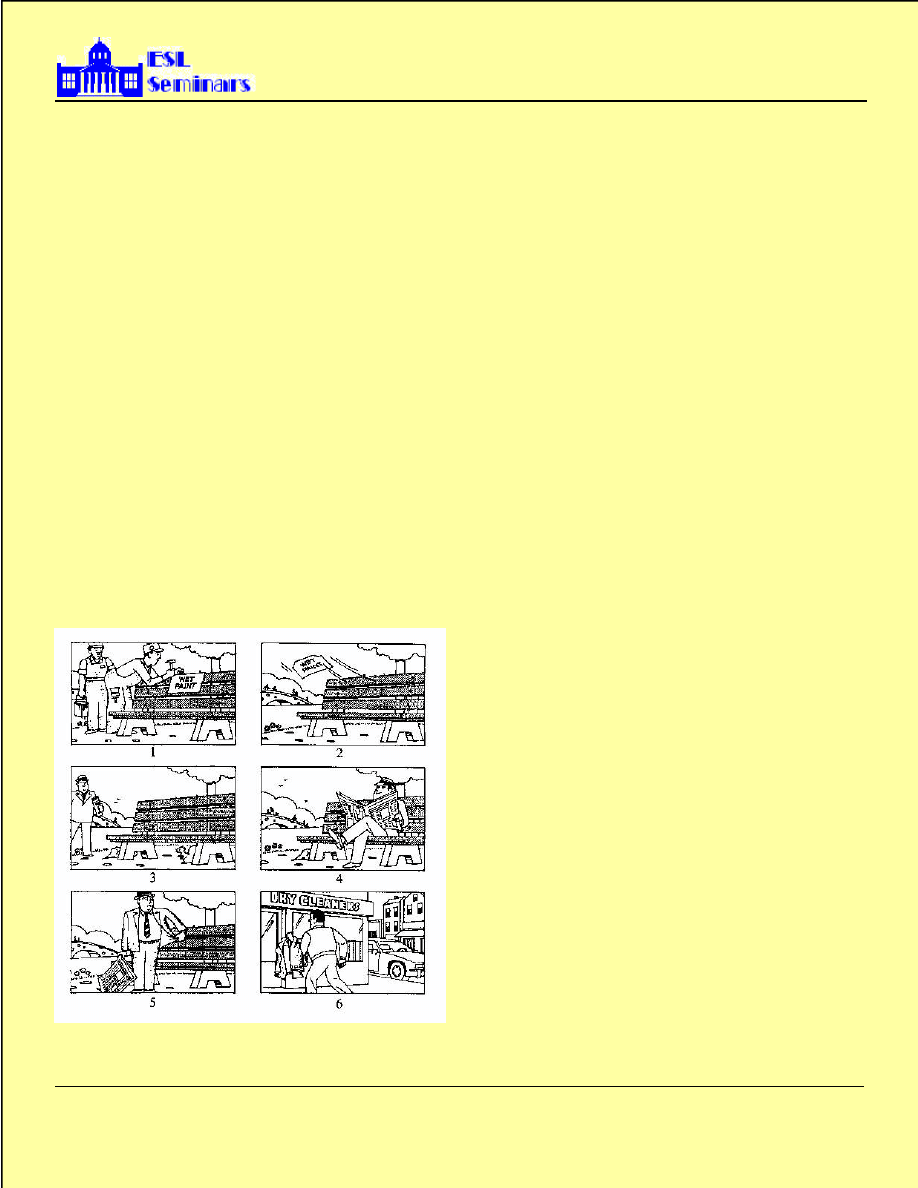
22
© 2003
ESL Seminars™
. All Rights reserved. No part of any
ESL Seminars™
material may be copied without express written authorization by
ESL
Seminars™
officials.
ESL Seminars™
are not affiliated with Educational Testing Service® (ETS®) and are not endorsed by them.
ESL Seminars™
offers no guarantees with it’s materials.
TSE
®
Sample Question Responses
The responses presented in this information packet are for the
questions posed in the sample test distributed by Educational
Testing Service®. They are for demonstration and practice pur-
poses only. Each response should take approximately 30 seconds.
Please note the words, phrases or sentences underlined. They
show you the most important part of the question. Also note the
way the important parts are fully addressed in the answer. NO-
TICE: The map related questions may be replaced by four new
questions. We have included the four new TSE® sample ques-
tions along with the traditional sample questions.
From the sample test: Now please look at the six pictures below
[next page]. I’d like you to tell me the story that the pictures show,
starting with picture number 1 and going through picture number
6. Please take one minute to look at the pictures and think about
the story. Do not begin the story until you are told to do so.
[In this exercise there is only one way to interpret the six pictures.
Therefore there will only be one sample response to this exercise.
Note that the instructions state: “starting with picture number 1
and going through picture number 6”. It is safe to assume that
you should talk about each picture separately and completely.
This is a test that also measures your cognitive and memory skills.
Hint: Learn to sharpen your observation skills!]
D. Tell me the story that the pictures show. (60 seconds)
“There is a panel of six pictures before me that tell a
story. In panel number one, there are two painters who
appear to have finished painting a bench. One of the
painters is nailing a sign titled “Wet Paint” to the back-
rest of the bench. The second painter is observing the
first. In panel number 2 the painters have left. The sign
that one of them attached to the backrest of the bench is
blowing off in the wind. In panel number 3 a man in a
suit and hat is approaching the bench. There is a small
squirrel hiding under one side of the bench and the “Wet
Paint” sign is barely visible on the ground alongside the
bench. In panel number 4 the man in the suit has sat
down on the bench and is smiling while he reads a
newspaper. In panel number 5 the man in the suit has
risen from the bench and has noticed that he now has wet
paint on the back of his suit coat and pants. He looks
very unhappy. In the sixth, and final, panel the man has
changed into a jacket and pants and is approaching a Dry
Cleaning store with his paint soiled suit coat and pants.
It appears that he intends to have them cleaned at the Dry
Cleaners.”
E. What could the painters have done to prevent this? (30 sec-
onds)
[Note: This question is solely about prevention by the PAINT-
ERS. You should limit your response to this topic alone. Hint: Do
not mention the man in the suit or other details – only the painters.]
“The painters could have used more than one sign to
warn passerby’s not to sit on the bench. They also could
have used additional nails or staples to hold the sign
more securely to the bench. In addition, they could have
mounted the sign on a stick and placed it in front of the
bench so that anyone approaching the bench with the
intent of sitting down would quickly observe the sign.
An extreme solution would have been for the painters to
stay near the bench until the paint was dry. That way
they could have warned people in person not to sit on the
bench. In any event, in this particular case the painter
that attempted to nail the sign to the bench did not do his
job well. He should have anticipated the wind and se-
cured the sign appropriately.”
F. Imagine that this happens to you. After you have taken the suit
to the dry cleaners, you find out that you need to wear the suit the
next morning. The dry cleaning service usually takes two days.
Call the dry cleaners and try to persuade them to have the suit
ready later today. (45 seconds)

23
© 2003
ESL Seminars™
. All Rights reserved. No part of any
ESL Seminars™
material may be copied without express written authorization by
ESL
Seminars™
officials.
ESL Seminars™
are not affiliated with Educational Testing Service® (ETS®) and are not endorsed by them.
ESL Seminars™
offers no guarantees with it’s materials.
[Please note that in this exercise you are being asked to imitate a
phone call. Hint: You are not face-to-face. You must use manner-
isms as if you were speaking on the phone to the clerk at the Dry
Cleaners.]
“Hello? Is this the Dry Cleaners? My name is (____your
name____), and I left a suit coat and pants with you a
little while ago. The clerk advised me at the time I
dropped them off that it would take two days to have the
paint removed from those items. I just found out that my
secretary scheduled me for a very important meeting
tomorrow morning. I am from out of town and that is the
only suit I brought. I really do need the cleaning com-
pleted by late today or early tomorrow. I hope you
understand that this is a desperate situation for me. I
cannot miss the meeting and the meeting is formal. It is
imperative that I wear that suit. Is there any way at all
that you could have it cleaned earlier than I was told?
Would it be possible for me to pay an additional fee for
any overtime or rush service fees? If you cannot get the
job done by early tomorrow morning is there anyone else
you could recommend. I certainly would pay you for the
time you have taken so far. Oh, you can have it ready?
Thank you very much. I will see you early tomorrow.
Good-bye!”
G. The man in the pictures is reading a newspaper. Both newspa-
pers and television news programs can be good sources of infor-
mation about current events. What do you think are the
advantages and disadvantages of each of these sources? (60 sec-
onds)
[Note: Give equal time to newspaper/television and good/bad
aspects of each. Hint: Do not talk about the man – the question is
only about newspapers and television.]
“Newspapers are one of the oldest forms of information
about news and current events. They have been in exis-
tence for over 400 years. They are inexpensive and easy
to take with you nearly everywhere. You may start
reading on a subject and then pause for as long as you
like before resuming your reading. The ink stays on the
page indefinitely. Newspapers also give high value for
the amount spent on them. Many newspapers contain
coupons to directly save on the cost of consumer items.
Newspapers can contain coupons worth hundreds of
times the actual cost of the newspaper itself. Newspapers
cannot give up-to-the-minute news reports. It is printed
at one specific time and any news that has happened
between the printing time and when you read it is lost.
Television, on the other hand, can give you up-to-the
minute news and information on current events. Televi-
sion is also capable of showing entire videos of events,
giving the whole picture rather than just one or two
pictures of any given event. Television also gives you an
opportunity to hear actual voices, sample music, and so
on. Televisions, though, are much more expensive than
a newspaper and it is impossible to wrap anything with
a television like you can with a newspaper.”
On the next page are more picture stores similar to the once above.
Practice telling what the panels mean on your own.
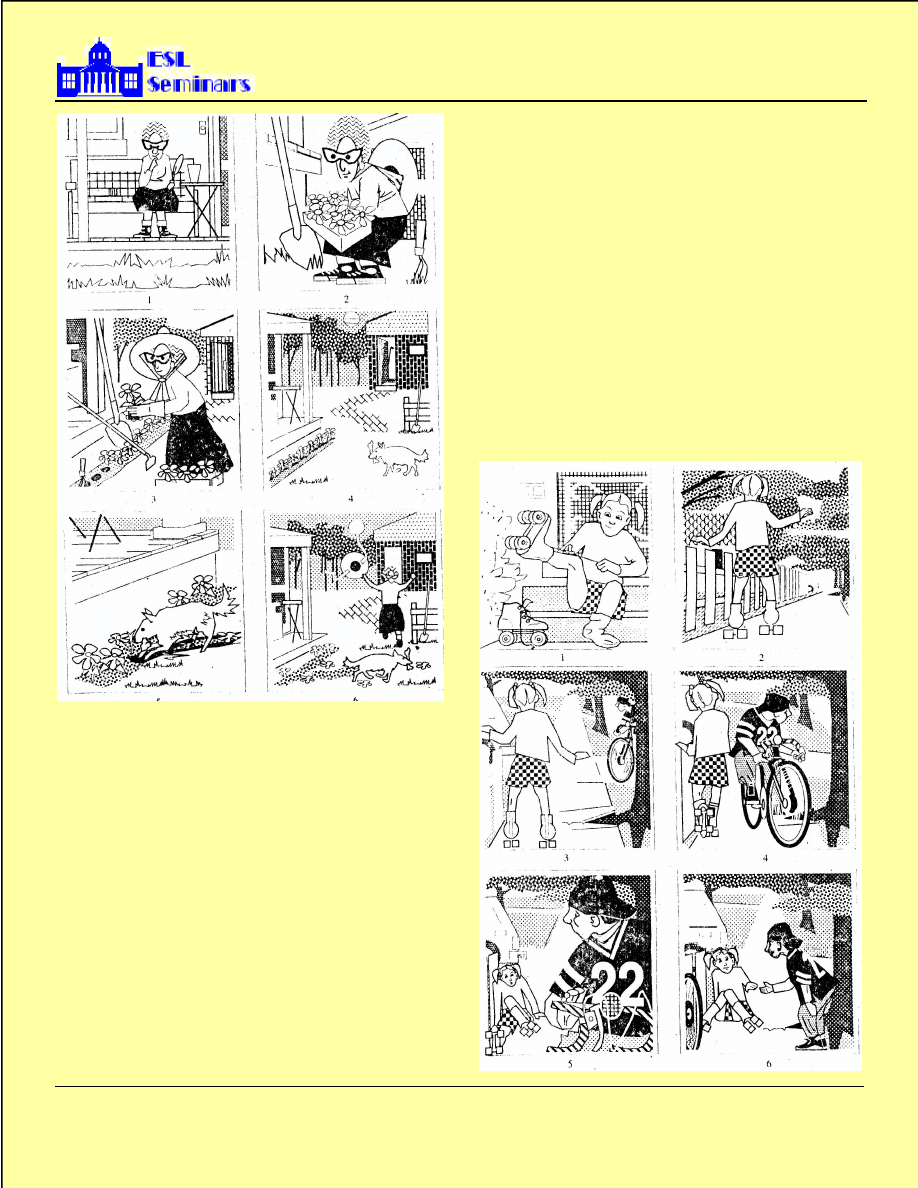
24
© 2003
ESL Seminars™
. All Rights reserved. No part of any
ESL Seminars™
material may be copied without express written authorization by
ESL
Seminars™
officials.
ESL Seminars™
are not affiliated with Educational Testing Service® (ETS®) and are not endorsed by them.
ESL Seminars™
offers no guarantees with it’s materials.
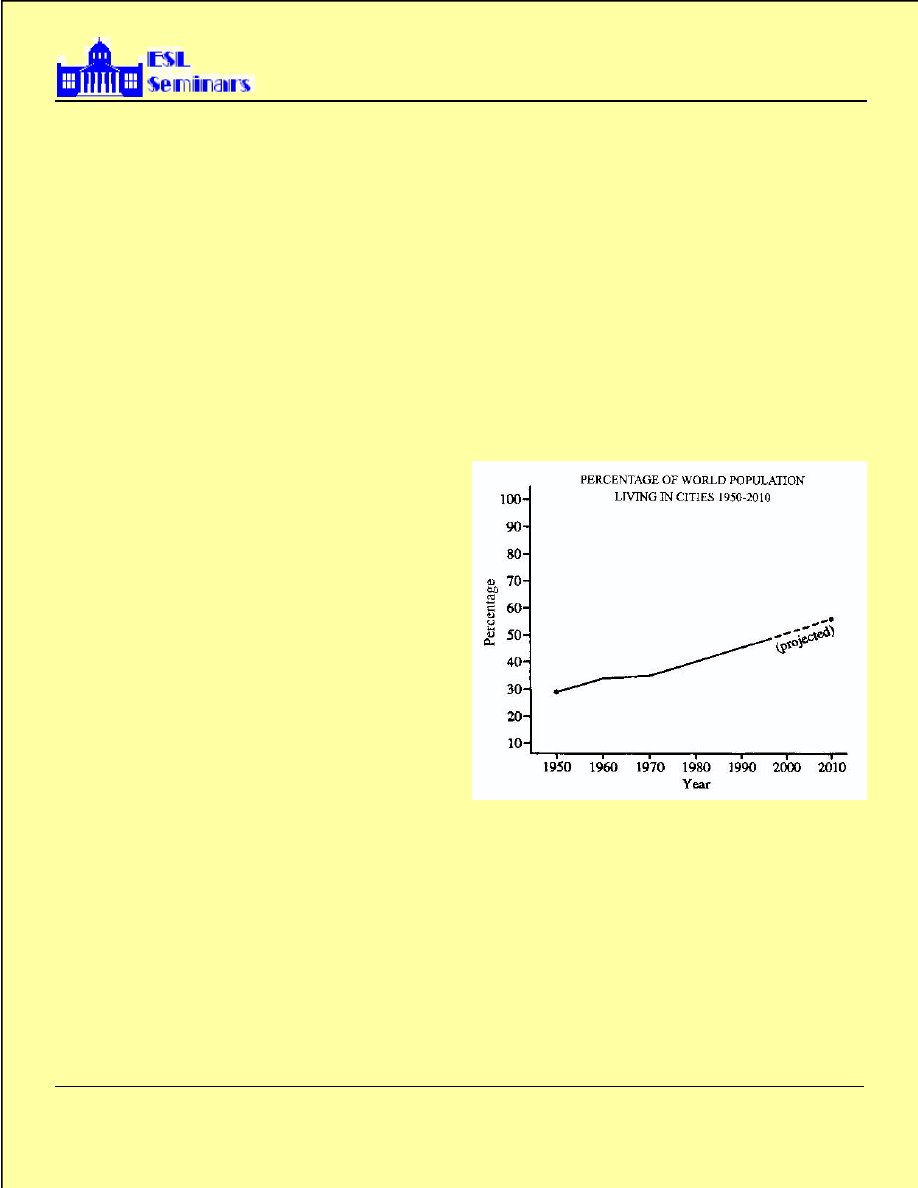
25
© 2003
ESL Seminars™
. All Rights reserved. No part of any
ESL Seminars™
material may be copied without express written authorization by
ESL
Seminars™
officials.
ESL Seminars™
are not affiliated with Educational Testing Service® (ETS®) and are not endorsed by them.
ESL Seminars™
offers no guarantees with it’s materials.
From the sample test: Now I’d like to hear your ideas about
several topics. Be sure to say as much as you can in responding to
each question. After I ask each question, you make take a few
seconds to prepare your answer, and then begin speaking when
you’re ready.
H. Many people enjoy visiting zoos and seeing the animals. Other
people believe that animals should not be taken from their natural
surrounds and put into zoos. I’d like to know what you think about
this issue. (60 seconds)
[Note: The interviewer is asking for your opinion, not two oppos-
ing opinions. Hint: Select which side of the subject you are on
(search your heart) then speak just to that one issue or side of the
subject.]
Pro answer – [Pro means “for”]
“I believe that zoos are not only enjoyable but also
necessary to the welfare of all kinds of animals. Zoos
protect and breed endangered animals that would proba-
bly become extinct without intervention. Zoos also do
much valuable research on non-endangered animals that
help the animals, man, and the environment. The educa-
tional value of zoos cannot be stressed enough. Children
and grown-ups can visit zoos and view animals that they
would not otherwise have an opportunity to see. Zoos
also effectively inform the public about the various
characteristics of animals. While providing wholesome
entertainment zoos also help to pass on appreciation and
admiration of the animals they display to the public.”
Con answer – [Con means “against”]
“Zoos are the cruelest way that the public can view
animals. Animals from all over the world are brought
into one small place. In that small place they are away
from their natural environment. They cannot forage for
food, as they would do naturally. They are given unnat-
ural foods, which is a detriment to their health and
well-being. Most breeding programs at zoos utilize un-
naturally small gene pools that weaken the species,
rather than strengthening them. The monies spent on
zoos would be better spent improving habitat for the
animals in their native lands. Worst of all, in times of
crisis, zoos are the first to be neglected and the animals
suffer needlessly. In war-torn countries many zoos run
out of food and animals starve. If war comes to their
natural habitats at least the animals could run away. They
cannot run away at a zoo.”
I’m not familiar with your field of study. Select a term used
frequently in your field and define it for me. (60 seconds)
[Note: Whatever your degree was awarded for, that is the subject
you should speak on. Hint: Pick a subject you are familiar and
comfortable with. Since this is such a personal question sample
answers cannot be illustrated except for the short sample below.]
I am a nurse. I have studied proctology. I would certainly
like to sign you up for a free extended proctology exam
for making me take this test …
[Second hint: The task here is for you to speak directly and
exclusively about a term that is specific to your field of study.]
J. The graph below presents the actual and projected percentage
of the world population living in cities from 1950 to 2010. Tell
me about the information given in the graph. (60 seconds)
[Note: Start at 1950 and at the roughly 29% level. Take each
decade and comment on it. Our hint – Make sure you say “the
graph shows” or something similar for each observation you
make about the graph. Especially mention that “the graph proj-
ects” for the period 2000 to 2010. The verb and tense change
throughout the story from past to present to future, etc. Watch for
those changes.]
“The graph shows the percentage of world population
living in cities for the period 1950 to 2010. It is graphed
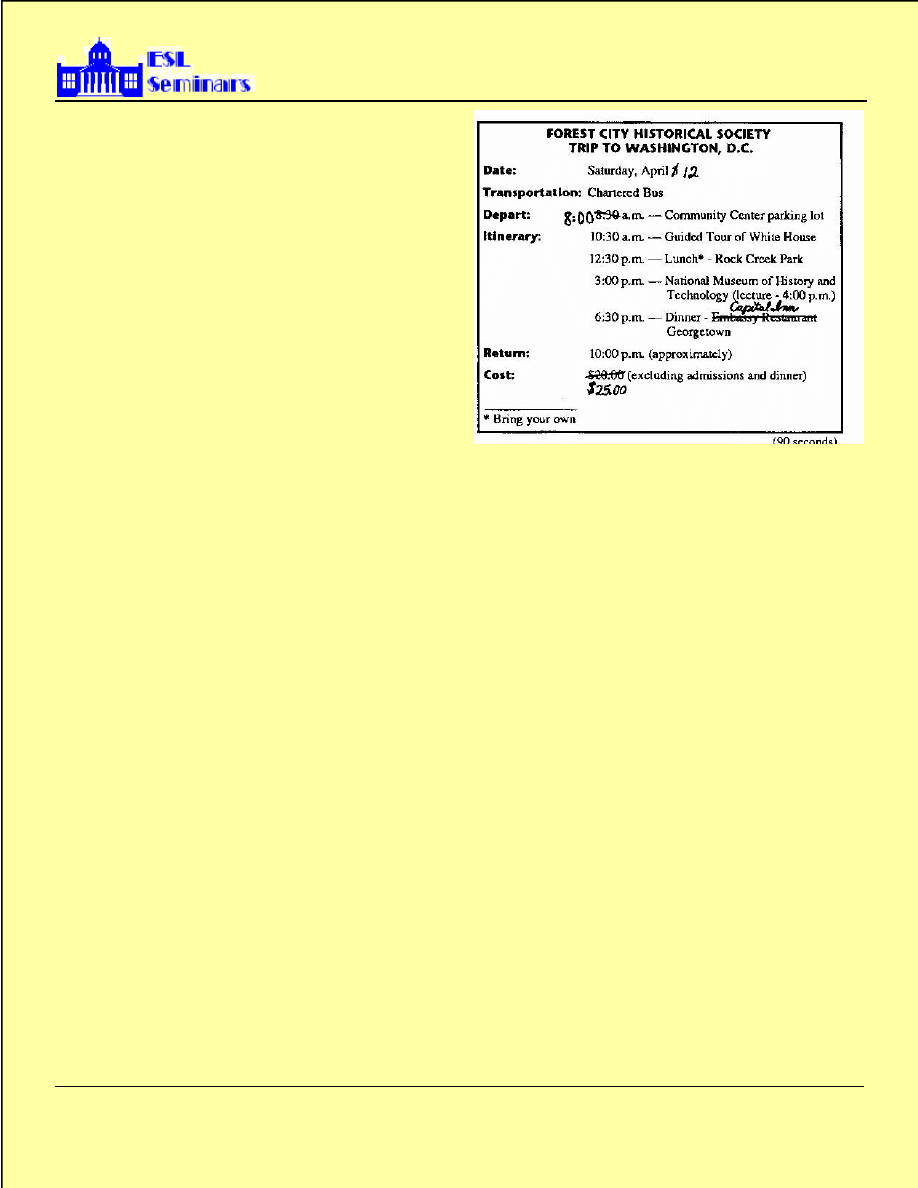
26
© 2003
ESL Seminars™
. All Rights reserved. No part of any
ESL Seminars™
material may be copied without express written authorization by
ESL
Seminars™
officials.
ESL Seminars™
are not affiliated with Educational Testing Service® (ETS®) and are not endorsed by them.
ESL Seminars™
offers no guarantees with it’s materials.
in ten-year periods and for percentages ranging from 10
to 100 percent in 10 percent increments. The graph
shows that in the year 1950 roughly 29% of the world’s
population lived in cities. By 1960 that percentage had
risen to 35%. There was little growth between 1960 and
1970, only about 3-percentage points. In 1980 the graph
shows that approximately 40% of the population were
living in cities. By 1990 the figure had risen to 45% and
by the year 2000 nearly half (50%) of the population was
living in cities. The graph projects that by 2010 55% of
the world’s population would be residing in cities. The
graph shows a steady movement toward a higher per-
centage of people living in cities. The only deviation
from this steady climb was during the 1960 to 1970
period.”
K. What might this information mean for the future? (45 seconds)
[Note: The questioner is asking you to predict the FUTURE from
past information. Our hint to you: Focus on FUTURE implica-
tions.]
“Observing the graph shows that the number of people
living in farming or rural areas has been, and will be,
reducing in number. I say will be because of the pro-
jected trend shown in the year 2000 to year 2010 time
period. There will be less people available to grow more
food for the world’s increasing population. The graph
also illustrates (if the figures are true) that many city-
type jobs need to be created in the future to ensure
employment for the many people moving to the cities. If
this graph is projected beyond the 2010 time point using
the same projection level shown, in just a few short
decades the vast majority of the world’s population will
be living in cities.”
L. Now imagine that you are the president of the Forest City
Historical Society. A trip to Washington, D.C. has been organized
for the members of the society. At the last meeting you gave out
a schedule for the trip, but there have been some changes. You
must remind the members about the details of the trip and tell
them about the changes indicated on the schedule. In your presen-
tation do not just read the information printed, but present it as if
you were talking to a group of people. You will have one minute
to plan your presentation. Do not begin speaking until told to do
so. (90 seconds)
[Note: You should speak as if you actually were the president of
the society and you must use a clear loud speaking voice. That is
what the evaluator is looking for. Try to be in command!]
“Attention, ATTENTION! May I have your attention?
“Thank you.
“At the last meeting, if you will remember, I passed out
a schedule, or itinerary, for our upcoming trip to Wash-
ington, D. C. Unfortunately I made some mistakes in that
schedule and we need to correct them tonight. We don’t
want you to miss the trip or have any misunderstandings.
“First of all, the date we are leaving has changed. I know
it isn’t easy to schedule your vacation times, etc., but we
have moved the trip back to Saturday, April 12. Please
make a note of that. If you do not have the printed
schedule I handed out last week please note the changes
on some other sheet that you can take with you. If you do
not have paper I can give you some half-sheets. We are
still traveling by bus but the departure time has been
changed to 8:00 a.m. You will have to wake up a little

27
© 2003
ESL Seminars™
. All Rights reserved. No part of any
ESL Seminars™
material may be copied without express written authorization by
ESL
Seminars™
officials.
ESL Seminars™
are not affiliated with Educational Testing Service® (ETS®) and are not endorsed by them.
ESL Seminars™
offers no guarantees with it’s materials.
earlier now. The itinerary stays nearly the same as before
with one major exception. For those of you who did not
bring their schedule this week please write down the
following itinerary that has not changed:
“At 10:30 a.m. we visit the White House. Next, at 12:30
p.m. we will have lunch at Rock Creek Park. Remember
that you will have to bring along your own lunch. Be
prepared to have it inspected if you have it with you at
the White House. At 3:00 p.m. we will visit the National
Museum of History and Technology. A lecture will be
given at the museum at 4:00 p.m. Now for the major
exception – Our dinner destination has changed. We will
now be dining at the Capital Inn in Georgetown. The
Capital Inn is a much better facility than what we had
previously planned. One other change might not be so
palatable. The cost for the trip is now $25.00 per person,
excluding any admission changes and dinner costs. I am
sorry for the increase but I am sure you will thoroughly
enjoy the trip and it is well worth the cost.
“OK. Are there any questions? Good. I hope to see you
on Saturday morning, April 12, at 8:00 a.m.!”
Well, that’s the end of the basic sample question answers. The
new questions are presented elsewhere in this publication Please
re-read and review all of them often. Imagine how the stories
would be in your own words because you MUST use your own
words. Do not memorize! Memorizing could very well cause
you to fail the TSE® exam. Write or type your own sample an-
swers to each question. The hand/mind connection made by
writing, typing, or note taking is powerful!
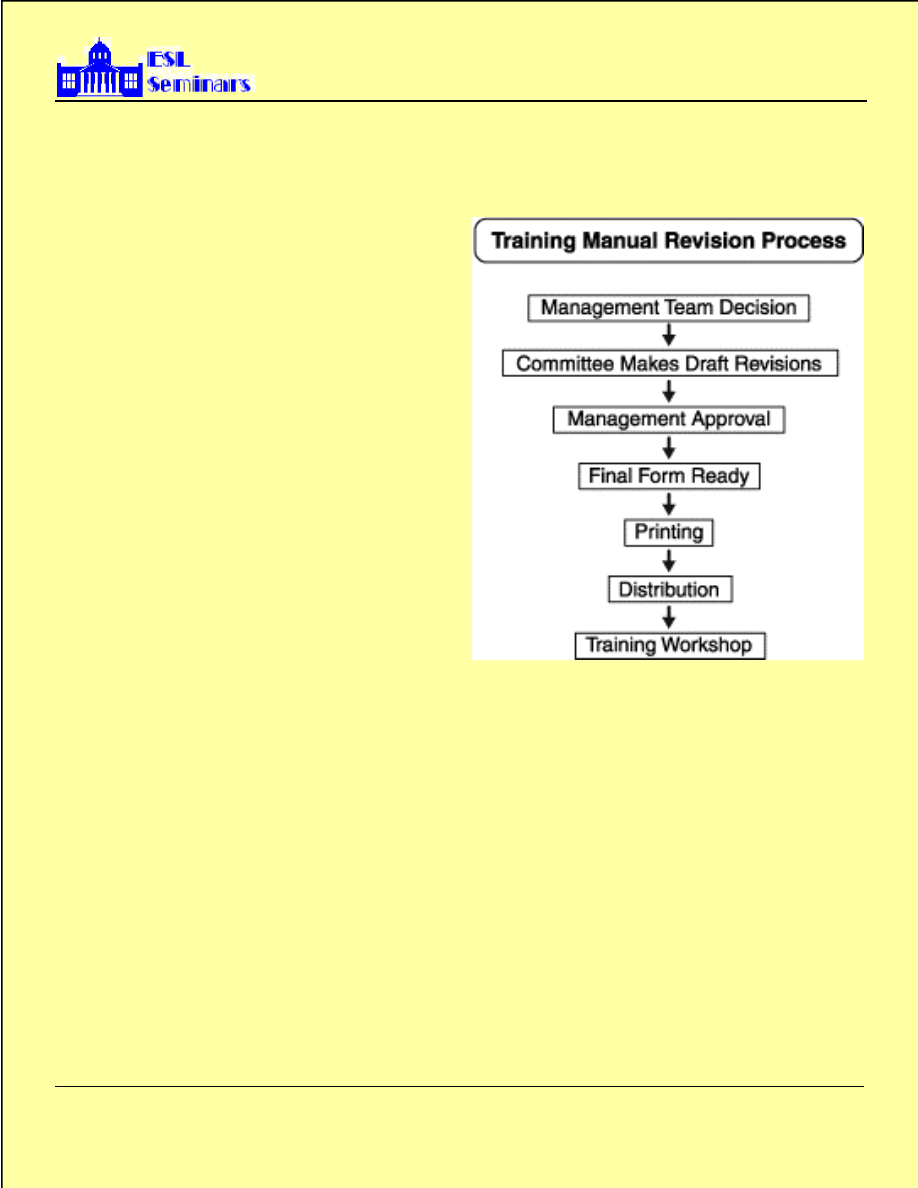
28
© 2003
ESL Seminars™
. All Rights reserved. No part of any
ESL Seminars™
material may be copied without express written authorization by
ESL
Seminars™
officials.
ESL Seminars™
are not affiliated with Educational Testing Service® (ETS®) and are not endorsed by them.
ESL Seminars™
offers no guarantees with it’s materials.
The Four New TSE®
Sample Questions With
Some Tips (Responses - Page 31)
The responses presented in this information packet are for the four
new questions posed in the sample test distributed by Educational
Testing Service®. They are for demonstration and practice pur-
poses only. Each response should take approximately 30 seconds.
Please note the words, phrases or sentences underlined. They
show you the most important part of the question. Also note the
way the important parts are fully addressed in the answer.
You will be asked to respond to a telephone message containing
a complaint. Imagine that you are the manager of a catalog
company that sells office furniture. After you hear the message,
you will have some time to prepare your response. In your re-
sponse be sure to
• show that you recognize the caller's problem, and
• propose a way of dealing with it satisfactorily.
Sample Pretest Question 10
Now listen to the voice message. (60 seconds)
Margaret: “Hello. My name is Margaret Willis. I'm calling be-
cause last week I ordered a wooden desk chair from your store.
The salesperson said it would be delivered in five days. They also
said it would be easy to put together. Well, I'm happy to say that
the chair arrived ahead of schedule, in just three days. But when I
tried to assemble it, I discovered that one of the legs was missing.
Please call me back today and let me know what you're going to
do about this. The model number of the chair is C50, and it is the
front right leg that's missing. This is the third message I've left,
and I am rather upset.”
Narrator: Now take 30 seconds to prepare your response to the
caller. Do not start your response until I tell you to do so.
Please begin your response now.
[Note: We have inserted the written text of what you hear from a
recording during the test. This text does not appear in the test
book and you will have to take notes, very good notes, to remem-
ber what was said. If you do not take notes on all of these new
questions you will probably not remember what was said and you
will FAIL.]
Sample Pretest Question 11
Please spend a few moments looking at this flowchart showing
the process used by a certain company when it revises its em-
ployee training manual.
Now you will hear a conversation about the revision of the
training manual for new employees. After the conversation, you
will have some time to prepare a report on the situation for Mr.
Jacobson, your supervisor at work. Please listen to the conversa-
tion.
You will have 45 seconds to prepare your report for Mr. Jacobson.
In your report you should talk about:
• what the situation is,
• what has been accomplished, and
• what remains to be done.
Do not begin speaking until I tell you to do so.
Narrator: Please spend a few moments looking at this flowchart
showing the process used by a certain company when it revises its
employee training manual.
Narrator: Now you will hear a conversation about the revision of
the training manual for new employees. After the conversation,
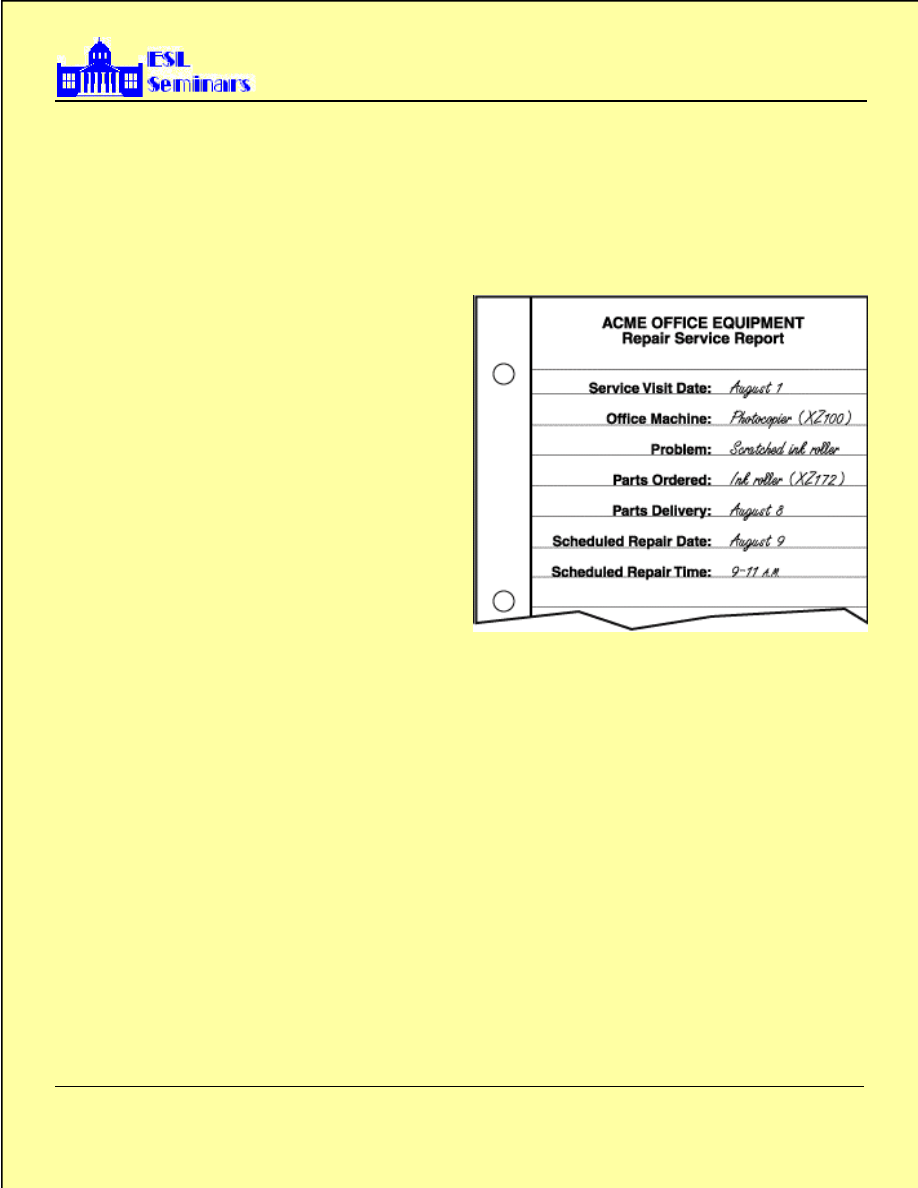
29
© 2003
ESL Seminars™
. All Rights reserved. No part of any
ESL Seminars™
material may be copied without express written authorization by
ESL
Seminars™
officials.
ESL Seminars™
are not affiliated with Educational Testing Service® (ETS®) and are not endorsed by them.
ESL Seminars™
offers no guarantees with it’s materials.
you will have some time to prepare a report on the situation for
Mr. Jacobson, your supervisor at work. Please listen to the con-
versation.
Ann: “Hi, Bill! Still working on that new employee training
manual that the management team decided to revise?”
Bill: “Oh yeah! It's been quite a job. I wish I hadn't been part of
the revisions committee.”
Ann: “There was a revisions committee? I thought it was just a
couple of you working on it.”
Bill: “No, the management team chose six people for the commit-
tee and we met a number of times. We eventually came up with a
series of draft revisions.”
Ann: “Did you agree on all the changes?”
Bill: “Oh no! That's too much to ask! Well, we agreed about a lot
of the revisions, but we ended up sending some to the manage-
ment team for them to decide.”
Ann: “And they're still arguing over it, right?”
Bill: “Nope! They chose what they wanted, approved it, and sent
it right back to us to prepare the final form for printing. And this
is it! This document is the final form of the revised manual! I'm
just taking it to be printed.”
Ann: “Really! That's great! And when will the new manuals be
back from the printers? We're waiting to give them to the new
employees to read through.”
Bill: “I expect you'll be able to distribute them on Tuesday next
week.”
Ann: “Wow! That means we could do the training workshop on
Friday. I'll set it up.”
Narrator: You will have 45 seconds to prepare your report for
Mr. Jacobson. In your report you should talk about:
• what the situation is,
• what has been accomplished, and
• what remains to be done.
Please begin your report now. [Note: The box above contains the
written text of what you hear during the test. This text does not
appear in the test book.]
Sample Pretest Question 12
Imagine that the photocopy machine in your office is out of order.
The technician sent by the office equipment company was unable
to fix the problem because an important part had to be ordered.
Your copy of the repair service report is shown below. Please take
a few moments to look at the repair service report. Then listen to
a telephone voice message that gives different information about
the situation.
Now you will have 30 seconds to prepare a response to this voice
message. In your response, you should
• explain the problem, and
• offer more than one possible solution.
Do not start speaking until I tell you to do so.
Narrator: Imagine that the photocopy machine in your office is
out of order. The technician sent by the office equipment com-
pany was unable to fix the problem because an important part had
to be ordered. Your copy of the repair service report is shown
below. Please take a few moments to look at the repair service
report. Then listen to a telephone voice message that gives differ-
ent information about the situation.
James Cook: “Hi, this is James Cook at Acme Repair and I'm
calling to confirm the repair visit our technician arranged with
you yesterday. As the service report form says, the technician will
be back out to repair your copier on August 15 sometime in the
afternoon. The technician does not carry parts. So the ink car-
tridges are being shipped to you. They will arrive by the end of

30
© 2003
ESL Seminars™
. All Rights reserved. No part of any
ESL Seminars™
material may be copied without express written authorization by
ESL
Seminars™
officials.
ESL Seminars™
are not affiliated with Educational Testing Service® (ETS®) and are not endorsed by them.
ESL Seminars™
offers no guarantees with it’s materials.
this week. Please be sure to have the parts available for the
technician when he arrives to do the repair. Thanks.”
Narrator: Now you will have 30 seconds to prepare a response
to this voice message. In your response, you should
• explain the problem, and
• offer more than one possible solution.
Do not start speaking until I tell you to do so.
Narrator: After the beep leave a voice message for James Cook,
explaining the problem and offering your solutions.
James Cook: [voice-mail filter] “You've reached James at Acme
Repair. Please leave your message after the beep.”
[Note: The box above contains the written text of what you hear
during the test. This text does not appear in the test book.]
Sample Pretest Question 13
Imagine that you happen to meet a colleague who has recently
received a promotion. Greet your colleague and be sure to
• mention the recent promotion,
• express your positive reaction to the promotion, and
• extend appropriate wishes to the colleague.
You will have 30 seconds to prepare your remarks. Do not start
speaking until I tell you to do so.
Narrator: Imagine that you happen to meet a colleague who has
recently received a promotion. Greet your colleague and be sure
to
• mention the recent promotion,
• express your positive reaction to the promotion, and
• extend appropriate wishes to the colleague.
You will have 30 seconds to prepare your remarks. Do not start
speaking until I tell you to do so.
Begin your remarks now.
[Note: The box above contains the text of what you hear and read
in the test book during the test, as well as the instruction to begin
speaking.]
Summation
Well, those are some questions, aren’t they. Do not forget that you
will not be reading those questions. They will be audio only, as
played on a tape recorder, and you must take accurate and copious
notes to remember the important points. The text is printed in the
exam booklet but the purpose of these four new questions is to
determine how well you listen to the task. However, you must
remember that this is a Test of Spoken English® and not a
comprehension exam. Your main concentration must be on how
well you speak English – and never forget that it must be Ameri-
can-style English.

31
© 2003
ESL Seminars™
. All Rights reserved. No part of any
ESL Seminars™
material may be copied without express written authorization by
ESL
Seminars™
officials.
ESL Seminars™
are not affiliated with Educational Testing Service® (ETS®) and are not endorsed by them.
ESL Seminars™
offers no guarantees with it’s materials.
Sample Answers To The
Four “New” TSE
®
Questions
Following are some sample answers to the sample
questions given by the TSE
®
on their web site. DO
NOT MEMORIZE ANY OF THESE SAMPLE AN-
SWERS. The actual questions undoubtedly will be
different that these questions so memorization will not
help at all. Secondarily, if you do memorize any an-
swers for the TSE
®
exam you will probably fail that
question and most likely fail the exam itself. There-
fore, as we admonish many times and in many differ-
ent ways, DO NOT MEMORIZE!
The actual TSE
®
sample questions are given immedi-
ately after this section.
Question Number 10 Responses:
Number 1:
“Hello, Margaret Willis? This is (your name) from the
furniture company. I apologize that your first calls
were not returned. I am the manager and I hope to
make things right for you. I have instructed my deliv-
ery staff to phone you and set up a time for them to
come to your house to repair the chair. I have the
model number you supplied, it was C50, right?, and the
leg is here in the shop. I hope that you will accept my
apology and that the delivery staff can have your chair
ready for you promptly. Thank you. Goodbye.”
Number 2:
“Hello? Is this Margaret Willis? Good. I am calling
from the furniture store in regard to the chair you
purchased from us. First of all, I would like to apolo-
gize that we did not return your calls promptly. I am
sure it is because we are closed on weekends. Never-
theless, you are our customer and you deserve a quick
response. There are many options you might choose
from. We could replace the chair, we could send a
person out with the missing leg and assemble the chair
for you, or you could return the chair for a full refund.
What would you like us to do? Very good. I will wait
for your decision by return phone call. Goodbye.”
Number 3:
“Ms. Willis? This is (your name) from the furniture
store. I am very sorry about the incomplete condition
of your chair. I am also horrified that your phone
messages were not returned promptly. Please accept
my apology. Please advise on how I might correct the
problem. Certainly we will be sending you a gift certif-
icate to compensate you for the non-returned phone
messages. That is just one of the ways we would like
to apologize. Next, we would be willing to do most
anything you would like to fix the situation. Please let
us know your wishes and we will comply. Thank you.
Again, my apologies. Goodbye.”
Question Number 11 Responses:
Number 1:
“Mr. Jacobson! I just overheard a conversation be-
tween Bill and Ann. They were discussing the em-
ployee training manual. It appears that the revisions are
finished. Bill was telling Ann that the manual is ready
for printing. They had some disagreements but the
management team made their changes and approved
the final draft. It should be back from the printers next
week. Ann is planning on using them for the training
workshop on Friday. That’s good news, isn’t it?”
Number 2:
“I have a report on the employee training manual
revisions, Mr. Jacobson. I overheard Ann and Bill
talking about the project earlier today. The revisions
have all been made. From what Bill said it was a
somewhat difficult process. In any event, the revisions
are all done and the manual is at the printers. Bill

32
© 2003
ESL Seminars™
. All Rights reserved. No part of any
ESL Seminars™
material may be copied without express written authorization by
ESL
Seminars™
officials.
ESL Seminars™
are not affiliated with Educational Testing Service® (ETS®) and are not endorsed by them.
ESL Seminars™
offers no guarantees with it’s materials.
believes that the manual will be back from the printers
next Thursday. Ann is planning on distributing them
Friday of next week at the training workshop. It ap-
pears that the process worked well and the project is
nearly done.”
Number 3:
“Mr. Jacobson? May I give you a report on the em-
ployee training manual revisions? The revised manual
is at the printers right now. The management team
decided on the revisions they wanted, approved it, and
sent it directly back to the committee. Bill told Ann
that the manual should be back from the printers on
Thursday next week. Ann wants to use them the fol-
lowing Friday. That’s what I overheard from Ann and
Bill’s conversation. Is there anything more you would
like me to find out about?”
Question Number 12 Responses:
Number 1:
“Mr. Cook, this is (your name). I received a voice
message from you earlier today. There appears to be
some discrepancies between your voice message and
the repair service report completed by your repair
person. Your repair person stated that the parts would
be in on August 8 and the repairs done on August 9.
Your message gave a different date. Please call me
back as soon as possible to clear this up or have your
repair person call. Possibly one of you could stop by.
My number is 123-4567. Thanks. I will wait for your
call. Goodbye.”
Number 2:
“ Hello, Mr. Cook? I am leaving this message because
you phoned earlier and left a message regarding our
copying machine. Your message is totally different
than what your repair person noted on the repair ser-
vice report. We need our copier fixed as soon as possi-
ble. I also note that the part you talked about in the
phone message is different that the part that was or-
dered. Could you phone me back to work this out? I
would also like you to see if you had phoned the wrong
company. So many details are different that I believe
you phoned the wrong customer. Thank you”
Number 3:
“Hello. Mr. Cook, I am returning the phone message
you left. There are many discrepancies between the
phone message and the repair slip left by your repair
person. Since we need this copier fixed immediately,
could you either send a replacement machine out for us
to use until our’s is fixed or could we just exchange
machines and possibly upgrade. Please phone me back
with options and prices. Thank you.”
Question Number 13 Response:
Number 1:
“John (or any name), I just heard about your promo-
tion. It’s wonderful. I couldn’t be happier for you. It is
really well deserved considering how much work you
have done in the past. If there is anything I can do for
you in the future please don’t hesitate to ask. Again,
congratulations!”
Number 2:
“Lucy, congratulations! Your promotion has just been
posted. It is a great step for you. I imagine that you
have worked for this promotion a long time. I hope you
remember me when it comes time to appoint your staff.
I have always enjoyed working with you. I hope that in
the future I can work for you!”

33
© 2003
ESL Seminars™
. All Rights reserved. No part of any
ESL Seminars™
material may be copied without express written authorization by
ESL
Seminars™
officials.
ESL Seminars™
are not affiliated with Educational Testing Service® (ETS®) and are not endorsed by them.
ESL Seminars™
offers no guarantees with it’s materials.
Number 3:
“Congratulations on your promotion, Fred. It is going
to a very deserving person. You have a very high
intelligence and an extraordinary work ethic. I hope
that you are ready for all of the changes. Now all of
your co-workers will be reporting to you. That will be
strange for us and I am sure it will be strange for you.
Even though it is strange, we are totally behind you.
Good luck!”
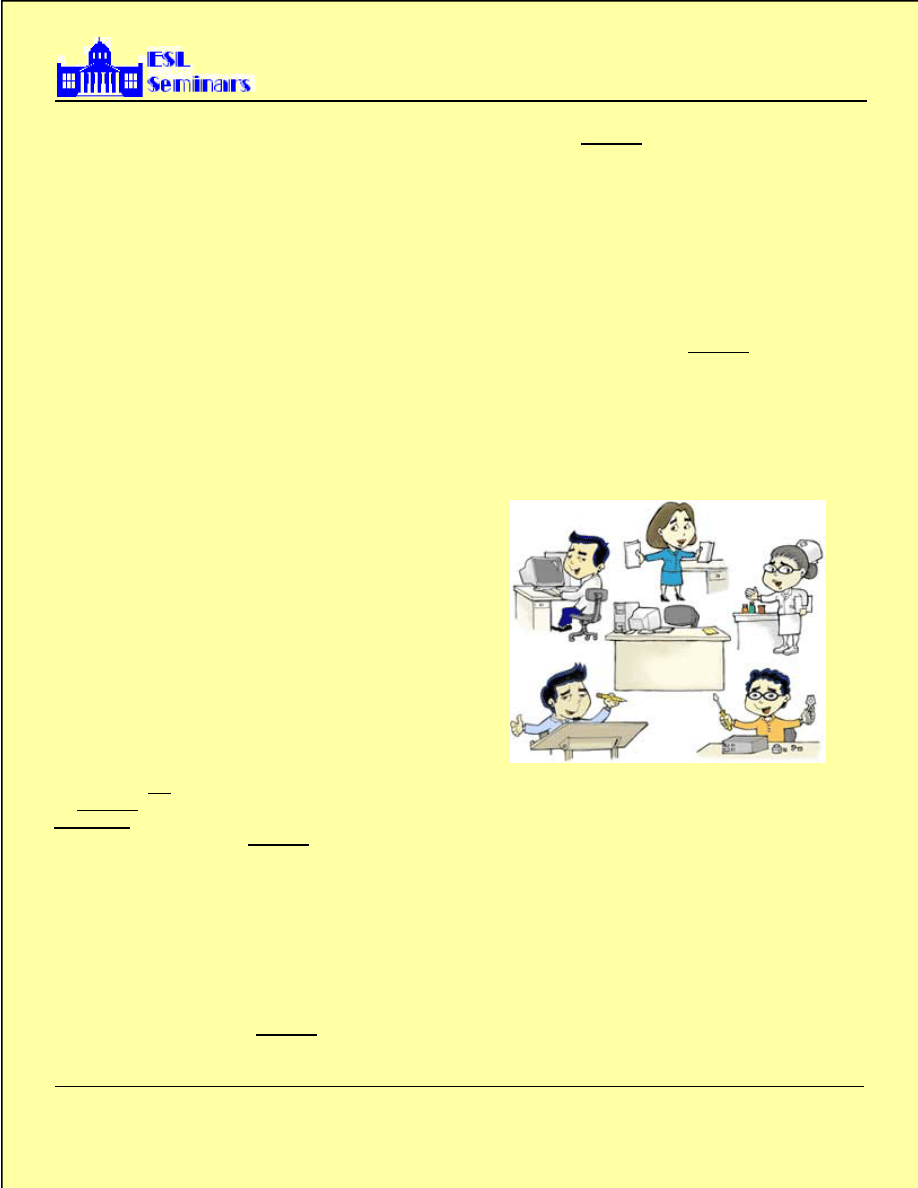
34
© 2003
ESL Seminars™
. All Rights reserved. No part of any
ESL Seminars™
material may be copied without express written authorization by
ESL
Seminars™
officials.
ESL Seminars™
are not affiliated with Educational Testing Service® (ETS®) and are not endorsed by them.
ESL Seminars™
offers no guarantees with it’s materials.
Some Gentle Admonitions
And Reminders
Many of you reading this booklet are from India, the Philippines,
or other Asian countries where English is spoken by many people
on a daily basis. You might even consider English to be one of the
predominant languages in your country. That belief could very
well give you a false sense of security regarding the English
language. When you fail the Test of Spoken English® (TSE®)
you will look back at “techniques” or “tips” you learned regarding
the content you expressed during the exam and not question the
quality of the words you spoke.
If you have failed the TSE® one or more times you are probably
dumbfounded that despite having such a wonderful background
in English that you still fail the exam. In short, you believe that
you are an excellent English speaker because you sound just like
other English speakers in your country. You received passing
grades on your English language classes in college, right? Unfor-
tunately for you, that means absolutely nothing to the TSE® exam
raters. But, with your English background the fault must be in the
content of your answer, right? Not at all. Please read on. It could,
and should, save you a lot of soul-searching and get your focus off
of figuring out how to get Sally to the Ice Cream Store with the
fewest number of steps.
Your English language instructors in your home country undoubt-
edly have told you that you are a good or excellent English
speaker. What you have been told in your native country by your
instructors won’t get you a passing grade on the TSE exam.
Chances are, your college English instructors couldn’t pass the
TSE exam themselves. Why? Let’s address that situation criti-
cally and completely.
Please keep in mind, as I have stated before, that I am not
criticizing anyone’s culture, background, or their normal day-to-
day English speaking abilities. What I must convey, however, is
that the person you need to satisfy when taking the TSE exam is
the American rater. That person’s ear is expecting you to speak
“American” English. Not the dialect you learned in your home
country. You MUST speak in American English tones. If you
speak too fast, as many of you from India and the Philippines do,
you will FAIL the TSE exam. If you do not pronounce words as
they are pronounced by Americans, in America, you will FAIL. If
you do not pause sufficiently at the end of each sentence you will
confuse the listener and FAIL the exam. If you do not speak in
complete sentences, you will FAIL.
Do not be so arrogant to believe that you know how to speak your
own style of English so well that the blame for your failure must
be with the rater. If you failed the TSE exam before, the fault is
entirely yours. You did not speak American English. Instead, you
spoke your own dialect, and that was not acceptable. It would be
far better for you to become a little more humble, accept that your
native style of English is not acceptable for the TSE exam, and
focus on learning American English.
One more thing: It is your responsibility to learn how to read a
map, how to interpret a pie chart, how to interpret a bar graph, and
all of the other subjects that might be a content segment of the
TSE exam.
ESL Seminars was designed to get you to speak
American style English and nothing more.
It must be pointed out here that
ESL Seminars is not a math,
physics, or science course. You should have learned all of those
subjects completely and thoroughly during your college years. If
you did not, or if you have forgotten, you must obtain that
knowledge in order to put your American English speaking
talents to work.

35
© 2003
ESL Seminars™
. All Rights reserved. No part of any
ESL Seminars™
material may be copied without express written authorization by
ESL
Seminars™
officials.
ESL Seminars™
are not affiliated with Educational Testing Service® (ETS®) and are not endorsed by them.
ESL Seminars™
offers no guarantees with it’s materials.
What Kind (Style) Of English
Do You Need To Speak
To Pass the TSE®?
In this document, and in the CD’s included with the seminar
materials, I have tried to be very direct with all of you and to
challenge you. I have been very blunt, and will continue to be
blunt. But, bear in mind there is nothing in this document or the
CD’s that should be taken as criticism, either of you, or of any
particular culture. The only goal here is to get you to the point
where you will pass the TSE® exam. You have to be able to alter
your speech patterns for just a short 12 to 20 minute period in your
life. By doing that you will get through the exam.
If you are from the Asia, as most of you listening should be, you
know that there is a general term for English as spoken by
Americans. You have probably heard it referred to as “slang”.
Well, it is not slang. Nothing could be further from the truth. What
you have heard, and will hear, are Americans speaking in their
own style of English. It is far removed from what the British
speak as their own English, but the American version of English
is what you need to master to pass the TSE® exam. One other
factor relating to your being from the Philippines: Most of you
who have taken the TSE® exam before received a score of either
40 or 45, with the majority receiving a score of 45. How do I
know? I know because I have reviewed the average scores for the
TSE® Exams held in the Philippines from the year 2000 to 2002.
A review of scores from the past few years in India shows the
same average of approximately 45. A score of 45 is not a passing
score.
The Educational Testing System® (or ETS®) has also produced
a very valuable sheet that illustrates why most Asians fail the test.
Overall, test takers from Asia sound as if they are struggling with
each answer. The speech has inadequate content and too many
“repair strategies” are used to compensate for language deficien-
cies. What all that means is:
Number 1, the speaker does not know English grammar, verb
usage, or noun usage well enough to use the right words. That
means the speaker is misusing English words and confusing the
listener, or rater.
Number 2, the speaker does not address who and what he/she is
asked to speak to. For example, when asked to make a phone call
the speaker does not use words or verbal mannerisms characteris-
tic with being on the phone. If you are asked to “pretend” if you
will to make a phone call use the standard “Hello” at the begin-
ning and “Goodbye” at the end.
Number 3, there is a lack of sophistication on the part of the
speaker. For example, the speaker is not direct in their statements
and takes on a subservient tone. The statements that are made are
hesitant and far too basic for an educated person.
Number 4, the speaker does not use logic and does not use
organized thoughts. The listener is confused as to what is being
said. There are no details given and the sentences are abruptly
started and ended. Remember, you must formulate your sentences
in a logical and linear manner. By linear I mean you start at the
start and end at the ending. Do not start a story in the middle and
then fill in details as you go on. Put the details in the beginning –
set the stage, so to speak.
Number 5, the speaker has a heavy dialect, or accent, and makes
errors in complex sentences. The speech is often too slow or
choppy. Word choice is often inaccurate. This error is inter-re-
lated to number 1, above.
That’s some list, isn’t it? We can take them all down into small
pieces that will be truly easy for you to handle. All of those
problems are thoroughly covered in this booklet.
As mentioned before, from a practical standpoint, you will only
have to speak in American “slang” long enough to pass the TSE®.
That is about 12 minutes. That is not much time, but you have to
change your speech patterns to pass the exam. After you pass the
test you can go back to your original “English” speech patterns,
although I wouldn’t necessarily recommend it. After all, you do
want to be clearly understood in Canada or the US if (when) you
travel there for work.
Please understand this fully:
The reviewers for the TSE® Exam are being very subjective when
they grade your tape. They might bring into play their own health
on the day they review your tape (for example, if they have a
headache), or if they are having problems on the job, or problems
at home, or any number of other factors – they will not necessarily
be kind to you. They are NOT grading you on a yes or no question
and answer basis. They are being subjective, not objective. There
are guidelines for them to follow but it is still subjective.
That does not work to your advantage. If you are difficult to
understand, or if you mispronounce words, it will make no differ-
ence to them if the actual words you are using are factual and well
constructed. They will probably not even pay attention to WHAT
you are saying at that point – only HOW you sound. On the other
hand, when they do hear you clearly they will then concentrate on
the content of your speech. That means you have to focus on both
facets: How you are speaking and what you are speaking.
So – first you have to get them to listen to you. That means
breaking away from your normal diction. It is as simple as that.
What do I mean by your normal diction? It means the style of
English spoken in your native land. Undoubtedly it does not
sound like American style English, but that American style
English is what you need to learn.

36
© 2003
ESL Seminars™
. All Rights reserved. No part of any
ESL Seminars™
material may be copied without express written authorization by
ESL
Seminars™
officials.
ESL Seminars™
are not affiliated with Educational Testing Service® (ETS®) and are not endorsed by them.
ESL Seminars™
offers no guarantees with it’s materials.
In regard to word usage, let me just use one simple word as an
example. The word is: PROJECT.
One way of pronouncing the word is: PROJ-ect. When pro-
nounced in that manner the word means a plan or a proposal. The
other way of pronouncing the word is: pro-JECT. That manner of
pronunciation means to thrust out or to throw forward.
Let that absorb in your mind for a while. Two different pronunci-
ations, two completely different meanings, but one exact same
spelling. If you mispronounce that word you could have a totally
different meaning than you intended.
What does that mean? It means you should obtain an American
English Dictionary and make it your inseparable partner. You
should take it with you everywhere. Read it while you eat. Read
it while in the bathroom. Read it while traveling. Make sure you
read the pronunciation guides.
An Important Task For You
At this time I would like you to perform one of the most important
tasks necessary to pass the TSE®. The task is for you to reduce
the number of words spoken from the average 90 per minute to
about 60 or 70. That will help you in a number of ways. You will
need a tape recorder for this and you should have a partner as well.
Why should you slow down your speech patterns?
First, it will make you pronounce your words clearer;
Second, it will give you a chance to collect your thoughts as you
speak and reduce the number of unintended pauses;
Third, it will give the listener a clearer mental image of what you
are speaking about;
Fourth, it will minimize any diction problems and the listener, or
rater, will have far fewer problems understanding your words.
When you practice, make a timed speech of one or two minutes.
Count the number of words you are able to speak in one minute
and reduce or increase the figure until you are speaking about 60
to 70 words per minute. It is a tedious task, to be sure, but well
worth the effort.
Why Would Printers Waste All That Space?
When you look at words printed in a book, or in a newspaper, or
even the words on this page, there is a tremendous amount of
space gone to waste. Look at all that space between the words and
the space wasted between the lines. Considering the high cost of
paper, why would anyone want to put in all that wasted space?
Itwouldbefareasiertojustputthewordstogetherlikethis,right?
When you speak too fast your speech ends up like that sentence –
not understandable. The reason the spaces are between the words
is that each word is a separate entity. When read with the eye the
mind must make a pause between each word to determine it’s
individual meaning. When you speak those same words, your
voice must put in the same spaces, or pauses, and it must also
verbalize the punctuation. By doing so your words will be clearly
understood, one by one, and you will give the listener, or rater,
confidence in what you are saying.
Words To Practice On
Let’s start with words that end in T-I-O-N or C-I-O-N. You
undoubtedly pronounce those four letters as: SHE-ON. That is
wrong. Those four little letters do not contain two syllables. They
contain only one syllable and should be pronounced as SHUN. If
you are in doubt, find an American English dictionary and review
the pronunciations.
Practice these words and make your voice emulate (or imitate)
American diction. For those recording their responses please
repeat each word after a pause. That way you will have many
examples for someone to critique your tape.
Attention.
Prescription.
Operation.
Congratulation.
Congregation.
Devotion.
Your voice should be a little flat and do not sharply emphasize
particular words as you might have spoken them in your native
country. For example, you might say sus-pish-SHE-on. The word
is actually pronounced sus-PISH-shun. Again, look up the pro-
nunciation guide of various words you have spoken in English in
any American dictionary. (Oh, by the way, it is not dic-SHE-on-
ary. It is DIC-shun-ary.) Look carefully at the pronunciations
given in the American dictionary. I am sure you will be surprised.
There are also some other phrases and words that I have found to
be troublesome for Filipinos and other Asians. One of the words
is strict. Strict is spelled S-T-R-I-C-T. There is a “T” at the end,

37
© 2003
ESL Seminars™
. All Rights reserved. No part of any
ESL Seminars™
material may be copied without express written authorization by
ESL
Seminars™
officials.
ESL Seminars™
are not affiliated with Educational Testing Service® (ETS®) and are not endorsed by them.
ESL Seminars™
offers no guarantees with it’s materials.
not a “K”. Remember to use gender denoting words correctly.
Men are he or him. Women are she or her.
Oh yes – one other key to your learning to speak American
English is to have immediate feedback, or criticism, of your
speaking by either recording your voice and playing it back right
away or by listening and doing the exercises of this CD with a
partner. You will have a great deal of trouble if you intend to just
work on your own. If you attended the
ESL Seminar you
know that a great deal of emphasis was put on networking with
your fellow attendees. The reason for that is so that you can call
on one or more people to partner with and to practice with.
Partnering is invaluable in evaluating each other’s spoken Eng-
lish.
A, E, I, O, U and Vocalize Your Punctua-
tion
Vowel usage is much different with American style English than
you are used to in Asia, no matter what your teachers have told
you in the past. All vowels are much less sharply spoken than you
might be used to. Listen carefully to my speech patterns on the
CD’s (if you have them) and how I pronounce vowels and indi-
vidual words. I know I have repeated this over and over, but you
must imitate my speech patterns as they are given on the CD’s or,
in other words, American speech patterns. I do not use slang. I
speak American English.
You should not sound as if you were giving a loud and stern
sermon. Do not over-emphasize words and make sure that you
vocalize punctuation. By vocalizing punctuation I mean that your
voice should change in reaction to normal punctuation marks.
Your voice should drop off at the end of a sentence to denote the
period.
For example: I left the computer on at work.
At the end of a spoken question the voice should rise slightly.
For example: What did you have for lunch?
Commas should have just a very short break in your voice.
For example: I went to the store to buy an egg, some bread, some
rice, and a very good tasting banana called a “saging”.
Exclamatory sentences should be spoken with some animation
but please don’t over-act.
Example: Hey, the fire station is on fire!
At this time I would like you to speak some phrases in an Amer-
ican English fashion. Record your voice and compare it to my
voice as it is on the CD.
1. I went biking with my neighbor. He is a Viking Foot-
ball fan.
2. My phone is malfunctioning. I have to take it to the
phone repair shop.
3. I drew a map of the town from the description given me
by Bob.
4. Your voice and body are interconnected.
5. I would like to work in this factory.
6. I worked in a cotton mill and know how to clean bins
and ventilators.
7. I enjoy creating simple designs.
8. I saw your ad in the newspaper.
9. When we travel we fly on a plane.
10. We would like to buy a house near the base.
11. Please paint the board to match the paint on the wall.
12. Does the bus stop on this corner?
13. I like natural foods and green vegetables.
14. The lady has a beautiful voice.
15. Bend over; the doctor will give you your shot now.
16. I like my fish and crabs to be very fresh.
17. Someone is trying to enter our house.
18. It is hard to study everything by yourself
19. Why will my spelling affect my score?
20. Some English words come from Latin or Greek origins.
21. In a republic we elect people to represent us and ex-
press our ideas.
22. We have a list of presents to buy.
23. How is this object used?

38
© 2003
ESL Seminars™
. All Rights reserved. No part of any
ESL Seminars™
material may be copied without express written authorization by
ESL
Seminars™
officials.
ESL Seminars™
are not affiliated with Educational Testing Service® (ETS®) and are not endorsed by them.
ESL Seminars™
offers no guarantees with it’s materials.
24. Will the store gift-wrap our presents?
25. My friend will translate for me.
26. I am working very hard to learn to speak, read and
write English.
27. Please promote me to a better job.
28. Make sure you drink plenty of fluids.
Well, how did you do? Did you mix up the “V’s” and “B’s”? How
about the “F’s” and the “P’s”? Did you over-pronounce any
words? If you did, you need additional work.
If you are able, record your voice, along with mine, by interacting
with our CD’s. When you play your recording back you will hear
distinctly the differences between your pronunciation and diction
and mine. Remember, you are trying to sound like me.
Let’s Wrap Up This Part
Let’s summarize.
First, make sure you use the correct pronunciation.
Second, be sure you know the subject you are talking about. If you
are asked on the TSE to give directions make sure you know your
right from your left and how to read a map! If the map has a
symbol indicating which direction is north then use the terms east,
west, south and so on to guide the fictional person you are giving
directions to. If there is no symbol then use left and right as the
terms.
Third, make sure you know which medical term you are going to
use. Do not memorize your explanation of that term but come up
with many different varieties of your explanation so that when the
time comes for the examination you are able to create a good
explanation from your extensive knowledge.
Fourth, as mentioned before, do NOT memorize. It will come
through clearly on the tape that you have memorized your state-
ments and the rater will keep your score down because of that.
Fifth, keep your sentences short and to the point. Lay out your
answers in a logical manner so you don’t have to repeat or go back
and fill in important points. Your ideas should come in a logical
order like 1, 2, 3, 4, etcetera.
Sixth, get a good night’s sleep before the exam and just don’t
worry about it.
Last, but not least, is to remember that you are an extremely well
educated person, with a magnificent background in the English
language. Go into the test room with the idea that you are going
to express that English in an American manner. You can do it. I
know you can do it. Exam time is when you demonstrate to the
TSE examiners that you certainly can speak American English.
If there are any of you that are hard pressed for independent
criticism of your spoken English (those that have not taken the
seminar and have not been evaluated during that seminar process)
you may send a sample tape to me. I really don’t want to be
inundated with tapes, but if you don’t have anyone else to evalu-
ate you, then send me the tape. I cannot return the tape to you, but
I will send a letter to you with my analysis. Make sure you put
your full name and clear address with the tape.
Remember, we strongly encourage you to register for the
ESL
Seminar™. That is the only true way to learn your spoken
English properly.

39
© 2003
ESL Seminars™
. All Rights reserved. No part of any
ESL Seminars™
material may be copied without express written authorization by
ESL
Seminars™
officials.
ESL Seminars™
are not affiliated with Educational Testing Service® (ETS®) and are not endorsed by them.
ESL Seminars™
offers no guarantees with it’s materials.
Words Are Your Tools
Just as a carpenter uses a hammer, a saw, and a plane, the speech
maker must use tools. Those tools are the actual words he or she
uses. They are verbal tools.
Let’s just look at what a carpenter uses when he or she builds a
house. Along with the basic hand tools and materials, the carpen-
ter must have a plan of what to do, or what to build. We call that
plan the “blueprint”. Blueprint is an archaic term referring to the
color of the paper and image, but that notwithstanding, a blueprint
is the complete detailed plan on how to build something.
When you build a speech, you must use a type of blueprint. You
must compose that blueprint in your mind but it must be detailed
and must be complete. In this case, you are preparing a blueprint
for a TSE® question response. That is quite different from a
general “toastmaster” type speech. What should the blueprint for
a TSE® response contain?
First of all, you need to keep in mind the topic you are speaking
to. What was, or is, the question(s) being asked of you. In a
“toastmaster” type of speech you would have an introduction
wherein you tell them what you are going to talk about. Then you
make your talk. At the end you review, or tell them what you just
told them. In the TSE® exam you must get right to the point and
answer the questions posed to you directly and completely. No
introduction segment and no concluding segment. Just the “heart”
of the subject.
Second, you must plot out the response directly to the question but
you must also put your thoughts into a logical order. If you are
asked, for example, to tell about the major parts of an automobile
from the front to the back you should not do this:
“At the very front is the front bumper. After that are the front
fenders and wheels, then the doors, oh, yes, ahead of the doors is
the engine, then …” The comment about the engine should have
been put into the correct order. The speaker forgot it and then
decided it was important so he inserted it out of order. That is not
an effective response to the question being asked.
Third, you must let the rater, or listener know that you are done.
Say something that denotes that you are finished with your
speech. It does not have to be long (in fact it should be very short)
but make sure to get the message across that you are finished. Do
not make a “toastmaster” type conclusion. If you are giving
directions say something like: “Well, that’s it. Good luck!”
Make Sure Your Tools Are Sharp!
One other way you can sharpen the effect of your word tools is to
vary the volume, rhythm, pitch, and pace of your voice to denote
changes in emphasis and other content variations in your speech.
By your voice alone you can show what parts of your spoken
answer are more important than others, etc.
In the content part of your speech you must make absolutely sure
that you answer every part of the question(s) posed by the TSE®
exam. There will be more on this later on in this booklet (page
37), but suffice to say that it is
ESL Seminars
belief that a
statement like “I don’t know anything about that subject and I
never received formal training on it” is a perfectly acceptable
way to begin your answer if you truly, honestly, do not know
anything about the subject being asked about.
Never forget, though, that words are very powerful tools. Peace
Treaties, Constitutions, Contracts, etc., are all composed of
words. Words can hurt, they can cure, they can depress, they can
enlighten, they can do a myriad of things. Use them carefully, use
only the ones you definitely know the meaning of, and use them
sparingly.
Have you heard of Benjamin Franklin? He was a famous Ameri-
can, an American envoy to France, a great politician, and one of
the founders, in fact, of the United States. He is credited in some
circles as discovering electricity with his lightning experiments.
But even with all of his political skills, and with all of his political
and scientific accomplishments, he wanted his tombstone to read
very simply: “Benjamin Franklin, printer”. Why would he want
to be known in posterity as just a printer? He desired that epitaph
because he understood extremely well the power of words. The
power of the Declaration of Independence, the power of the
Constitution. They are made up of mere words, but they changed
the course of human events over 200 years ago and words con-
tinue to change human events on a continual basis.
Just as we started off this section, you must remember that, like a
carpenter, you must use a blueprint to start developing the frame,
or “skeleton” of your responses. You must address certain spe-
cific subjects in answering the questions and use those as your
“skeleton”. Those subjects that will make up your “framework”
can be summed up in six one word questions:
Who?
What?
Why?
When?
Where?
How?
See page 38 for more on those subjects.

40
© 2003
ESL Seminars™
. All Rights reserved. No part of any
ESL Seminars™
material may be copied without express written authorization by
ESL
Seminars™
officials.
ESL Seminars™
are not affiliated with Educational Testing Service® (ETS®) and are not endorsed by them.
ESL Seminars™
offers no guarantees with it’s materials.
The Best Speaking Tool
Is Listening
With the advent of the four new TSE® exam questions (the first
part of 2003) the art of listening becomes even more important for
you. Those new questions will be posed to you orally, or via tape
recorder. That means you will hear conversations, or verbal inter-
actions, on the tape recorder and you must take notes of the
important points to enable you to formulate your answers correct-
ly.
If you do not take full and complete notes, you will probably fail
one or more of those new questions.
The Educational Testing Service® is now allowing you to bring
a pencil into the testing room. The purpose of that is to let you
take notes on those oral questions. Make sure your pencil is
sharpened and do not break the lead. Maybe you should bring a
mechanical pencil or possibly a pen.
You must become adept at determining which parts of what you
hear are the important points. If you are comparing a written sheet
to what is being spoken you must be very alert to any changes the
person speaking to you on the recording is making from the
written account. Any discrepancies will be critical to your re-
sponding correctly.
What exercises can you do to become more proficient at listen-
ing? The one very important thing you can do when listening is
keep your mouth shut! Your ability to listen effectively is reduced
by about 99% when you try to speak when you should be listening
intently. Essentially, what I am saying is that the moment your
mouth opens, your ears slam shut. So, keep your mouth shut and
stay quiet while listening. Give what is being said your undivided
attention.
What else can you do? Lots of things. One exercise that is very
effective requires that you have a partner. In this case, the partner
must keep their mouth shut also and be somewhat skilled at
listening.
The task is this: You should listen to an English language news
report on the radio. Take notes of each story being reported. After
about 5 to 10 minutes, re-tell each story in your own words,
working from your notes, to your partner. The partner can then
give you immediate feedback as to how accurate you were in your
retelling. If you have taken our seminar, you will quickly realize
that the instant feedback is very effective and doing it this way
mimics our techniques in the live seminar itself.
Keep repeating this task until you become extremely proficient at
taking notes. You should also work diligently on correct pronun-
ciation and diction in your English retelling of the stories. Re-
member, and never forget, you are trying to speak in an American
style of English.
One other aspect of good listening is to be fully aware of when
you should begin recording your response to the TSE® questions
being posed to you. Many TSE® exam takers have failed on one
or more questions when they failed to realize, and failed to listen
to, directions for them to begin their answer. They literally just sat
silently in front of the recorder while the time allotted for their
answer just ticked by. Missing just one question in that fashion
caused many exam takers to fail. That one answer they failed to
record could have been all they needed to pass.
The moral is: Except for when you are actually recording your
answer to a question, keep your ears and mind fully open and your
mouth closed.

41
© 2003
ESL Seminars™
. All Rights reserved. No part of any
ESL Seminars™
material may be copied without express written authorization by
ESL
Seminars™
officials.
ESL Seminars™
are not affiliated with Educational Testing Service® (ETS®) and are not endorsed by them.
ESL Seminars™
offers no guarantees with it’s materials.
If You Really Don’t
Know The Answer,
Be Brave Enough
To Say So!
The TSE® exam is not a math test. It is not a physics test. It is not
a biology test. It is also not a skills test in how to read a map or
how to read a cartoon. It is a Test of Spoken English. The name
is fairly self-explanatory. However, to assess your ability to
converse in English you must be asked some specific questions.
The expectation is for you to address the question(s) directly,
completely, and comprehensively. Your speech must have struc-
ture, logic, and definition. Therefore, you must answer each
question directly and completely, to the best of your ability.
But, and this is a BIG but, there is a chance that you will be posed
with a variation of a question that you had not anticipated. Not all
of the questions on the actual TSE® exam will be exactly as the
samples are on the TSE® sample questions sheet. If you find that
you are being asked something that you truly have no knowledge
about, we believe it is far better for you to be honest and forth-
coming about your abilities rather than to stammer and stumble
trying to create a false answer.
Being dishonest in your answer, or trying to make something up,
will cause all kinds of physical changes to your body. It will cause
dryness of the mouth, nervousness, elevated heart rate, elevated
breathing rate, etc. It will distract you and tend to cause mistakes
on following questions that you might know a great deal about.
Our advise is to very simply say something like: “I don’t know
anything about this subject matter, but I believe I would tell my
colleague this …” and then go on with what you think would be
the correct answer. Why do we say this?
First, the honesty gives you a great deal of credibility.
Second, that same honesty will probably get a greater degree of
attention by the rater. That means that the person listening to your
recording will pay more attention to your words and will, uncon-
sciously, being to understand your speech patterns better than
they had before.
Third, your honesty gives you much more confidence and you
remain in control of yourself and your response.
Our point in this section is to advise you to be totally honest in
your responses. If you are not educated in the topic being asked,
make sure you communicate that. Certainly you must try to
answer the question to the best of your ability, but do so in an
honest manner.
As has been mentioned to you in other sections of this booklet, it
is your responsibility to learn how to read a map, read a bar graph,
read a line graph, and, when asked to do so, to take accurate and
complete notes of things you listen to. It is absolutely your
responsibility to do those things.
You are a college graduate. With that status comes certain respon-
sibilities to use logic, and to be able to reason things out. You
have the certificates and diplomas that show you are a highly
educated and highly intelligent person. When you take the Test of
Spoken English® you must prove those abilities.

42
© 2003
ESL Seminars™
. All Rights reserved. No part of any
ESL Seminars™
material may be copied without express written authorization by
ESL
Seminars™
officials.
ESL Seminars™
are not affiliated with Educational Testing Service® (ETS®) and are not endorsed by them.
ESL Seminars™
offers no guarantees with it’s materials.
Who?
What?
Why?
When?
Where?
How?
If you haven’t heard those six words before in a speech making
context you better memorize them now! Those are the six things
you absolutely need to address each time you give a speech or
answer a question. If one of those do not apply to what you are
saying then skip it. However, most, if not all, will apply every
time you answer a TSE® exam question.
It has been said by far greater minds than myself that when
reading a newspaper article, you can get all the basic information
from just the first and last paragraphs. Having been a newspaper
writer and editor for a number of years, I have found that to be
true. True, that is, in all well written newspaper articles.
One task you might take on is to read articles in one of the larger,
prestigious, newspapers you can find. Try the “first and last
paragraph” technique and see if it applies. What you will be
looking for is how the writer addresses each of the six questions
above. The “Who?, What?, Why?, When?, Where? and How?”
Once you realize how those questions are answered in newspaper
articles, you should start to apply the same techniques to your own
responses to the TSE® sample questions.
Let’s take them one at a time:
Who?
Who is the subject of the story? Is it a person? Is it about a thing?
Who (or what thing) is the subject of the story about?
What?
What happened to cause you to tell the story? Why is a repairman
coming? Why are you telling someone about a picture?
Why?
Why did the even happen? Why are you returning a call? Why do
you need to tell the story?
When?
When did the event happen? Did it (what you are being asked
about) happen yesterday? Today? Right now? Will it happen
tomorrow or later? This question affects the verb tense you will
use in your story. You must get your verb tenses right!
Where?
Where did the event happen or where will it happen?
How?
How did the event happen or how will you resolve the problem?
How will a resolution be made?

43
© 2003
ESL Seminars™
. All Rights reserved. No part of any
ESL Seminars™
material may be copied without express written authorization by
ESL
Seminars™
officials.
ESL Seminars™
are not affiliated with Educational Testing Service® (ETS®) and are not endorsed by them.
ESL Seminars™
offers no guarantees with it’s materials.
Some Particularly
Troublesome Words
Let’s work with some words that are consistently
pronounced incorrectly as compared with the actual
pronunciation given in American English dictionaries.
The correct syllable emphasis is shown in capital let-
ters. This is a short list but illustrates how you might
mispronounce some of these words.
Notice----------------------------NO-tice
Argument-----------------------AR-gu-ment
Arithmetic-----------------------AR-ith-metic
Attainment----------------------at-TAIN-ment
Decide---------------------------de-CIDE
Propeller-------------------------pro-PEL-ler
Propellant-----------------------pro-PEL-lant
Housewife-----------------------HOUSE-wife
Mutual---------------------------MU-tu-al
Cement--------------------------Ce-MENT
Suburban------------------------Sub-URB-an
Institution-----------------------In-sti-TU-tion
Franciscan-----------------------Fran-CIS-can
Franchise------------------------FRAN-chise
Facilitate------------------------Fa-CILI-tate
Inventory------------------------IN-ven-tory
Commercial---------------------Com-MER-cial
Purification---------------------PUR-i-fi-ca-tion
This list will be added to on a continual basis.

44
© 2003
ESL Seminars™
. All Rights reserved. No part of any
ESL Seminars™
material may be copied without express written authorization by
ESL
Seminars™
officials.
ESL Seminars™
are not affiliated with Educational Testing Service® (ETS®) and are not endorsed by them.
ESL Seminars™
offers no guarantees with it’s materials.
Gender
Those of you brought up in India, the Philippines, and
other Asian countries, are used to conversing without
regard to gender distinctions. Differences between the
sexes and differences in age, family position, are given
in ways not like those used in the English Language.
When speaking about men, or male subjects, you must
use him, he, his, etc.
When speaking about women, or female subjects, you
must use she, her, hers, etc.
If you are speaking about a male subject, and some-
where in your answer you refer to that male person as
a “her” you will confuse the rater and you could very
well fail on that question.
It may very well seem inconsequential to you if you
ignore correct gender usage but it is an important and
integral part of the English language.
My experience with students from all over Asia has
brought me to the firm conclusion that gender mistakes
are endemic throughout that region of the world. I have
no tips on how to easily rectify this ever-present prob-
lem. I cannot wave a “magic” wand and make it all right.
All I know is that the problem MUST be corrected and
if this takes some additional study on your part you
must take the time and effort to do so.
What If You Just Cannot Fix It?
The best strategy is to use proper names and avoid the
use of all pronouns. Sometimes the problem can be
insurmountable and this strategy will take you away
from the danger zone of improper pronoun use (gender
problems).

45
© 2003
ESL Seminars™
. All Rights reserved. No part of any
ESL Seminars™
material may be copied without express written authorization by
ESL
Seminars™
officials.
ESL Seminars™
are not affiliated with Educational Testing Service® (ETS®) and are not endorsed by them.
ESL Seminars™
offers no guarantees with it’s materials.
Plain Language Strategies
To Creating Sensible Answers
For the TSE® Exam
Let’s start this section off with the strong admonition
to not memorize any answer to any Test of Spoken
English® question. It will be readily apparent that you
have done some memorization and that recitation of
memorized material will cause you to fail any given
question in which you give a memorized answer. Just
don’t do it.
It is the belief of
ESL Seminars
that there is no way
to convey, or develop, a “basic strategy” to answer any
given question on the Test of Spoken English®. Using
“common sense” is the better and most effective meth-
od. We further believe that the TSE® is best ap-
proached with conversational American style English.
With that in mind, there are some general areas of spe-
cific focus that you must concentrate on.
Any of the questions posed on the TSE® exam can be
correlated with general conversational statements,
questions, etc., that you would normally encounter by
speaking with actual colleagues or friends.
What the hell does that mean? It means the questions
given on the TSE® exam are the same as questions
normally, and frequently, asked you by your boss,
workmates, friends, your brothers, your sisters, etc.,
during your daily life.
For example, if you are asked about the ingredients
that make up your favorite meal you would be greeted
with strange looks if you answered by describing the
color of your clothes. Just as you expected to answer
only the questions asked in your real life, when taking
the TSE® exam you must only answer (but answer
completely) the question(s) asked.
Get to the point, make direct statements, then wrap up
the answer quickly.
Giving a Personal Description
If you are asked to give a personal description, such as
when someone is to meet you at an airport, or bus sta-
tion, etc., make sure you give a complete “picture” to
the listener. You should also personalize your state-
ments by using the pronoun “you” where appropriate,
just as you would when talking directly to someone –
because that is exactly what you are doing: Talking to
someone. You should also give details such as your
sex, your weight, your height, your clothing, your hair
color, and also your location.
Telling About Your Daily Routine
Questions asking you to relate your daily activities
should be answered in a chronological order. Start in
the morning and end in the evening (from wake-up to
sleep). You could also arrange the day in quarters, or
eights, or whatever you deem comfortable. Tense is
important in answering questions of this type and
should be simple present in all cases. Words that ex-
press time (temporal markers), such as “then” or
“next” should be used to show the progression of your
day.
Suggesting A Gift
If you are given a task to verbalize recommending a
gift you must make sure to describe the gift in positive
terms. By positive terms we mean that you should
speak to the attributes of the gift. Along with the attri-
butes you must also speak to the benefits to the person
you are talking to if they were to buy the gift you are
suggesting. It is also important to remember that you
should include information on where they can buy this
gift. Remember also that you are not giving commands
during this task. You are making recommendations
and giving positive rationale for your recommenda-
tion. With that in mind you must use words such as
“should”, “would”, “could”, and “might” during
your response.

46
© 2003
ESL Seminars™
. All Rights reserved. No part of any
ESL Seminars™
material may be copied without express written authorization by
ESL
Seminars™
officials.
ESL Seminars™
are not affiliated with Educational Testing Service® (ETS®) and are not endorsed by them.
ESL Seminars™
offers no guarantees with it’s materials.
Recommending A Place To Visit
This is another map oriented question that might be re-
placed in the near future. However, if it is included on
your exam you must be prepared. In this question you
will be asked to recommend that your friend of col-
league visit a certain place you pick out on the map and
then justify that recommendation. We advise that
along with justifying your recommendation (using the
word “because”) you also give brief directions to the
destination. At very minimum you should mention
what it is located near. Be sure to stress the reasons
why you are making the recommendation.
Giving Directions
This task is also map oriented. It is imperative that you
use words such as: “east”, “west”, “north”, “south”,
“right”, “left”, “in front of”, “behind”, “straight”, etc.
Be sure that you also know the meaning of city street
nomenclature such as “block(s)”, “door(s)”, etc. Keep
in mind that you are talking directly to a person and
giving that person your instructions.
Describing Your Favorite Movie
And Why You Like It
Three parts constitute the answer to this question. You
must name the movie, describe what the movie is
about, and then recommend the movie to the person
you are talking to. Try to stress the positive aspects of
the movie, as if you were making a recommendation.
It is certainly alright if you do make a recommendation
of this movie to the person you are talking to.
Describing A Series Of Pictures
This is a task where you must use a verbal timeline to
place the pictures in the proper order. It is recom-
mended that you mention how many pictures make up
the story and to mention them by number when telling
about them. You should use words such as “when”,
“so”, “then”, “and”, to mark shifts in time, or pro-
gression of the story in the pictures. It is imperative
that you examine each picture carefully when you de-
scribe it so that you include all the important details
which actually make the story make sense. One way to
practice for this question is to read cartoons to children
from newspapers or comic books. If you do this, how-
ever, make sure you use English.
Suggesting A Preventative Action
This is one of the follow-up questions to the task of de-
scribing the picture story. You must recommend what
action(s) the painters could have taken to prevent the
accident shown in the series of pictures from happen-
ing. You should use words such as “might have” and
“could have”. There are many different solutions to the
problem. It is perfectly alright, and highly recommend-
ed, that you offer more than one solution.
Imagine Yourself In The Story
And Phoning a Dry Cleaner
This task requires that you put yourself into the picture
story and imagine that you are the one that experiences
the events shown in the pictures. In the TSE® sample
questions the event is that you have sat down on wet
paint. You now have soiled clothes and you must deal
with the situation. The situation is that you leave the
clothes at the dry cleaners (which takes two days to
clean) but then realize that you need the clothes the
next morning. Remember that this is a phone call and
that you must use words characteristic with phone
calls: “Hello”, “Goodbye”, “Is this the dry clean-
ers?”, etc. You must also be very persuasive, convinc-
ing, and insistent. Do not forget to tell them who you
are, why you brought the clothes in, and the very im-
portant reason you need the clothes cleaned early.
Advantages And Disadvantages
To Newspapers and Television
The picture story becomes a segue to telling about
newspapers and television. This task requires you to
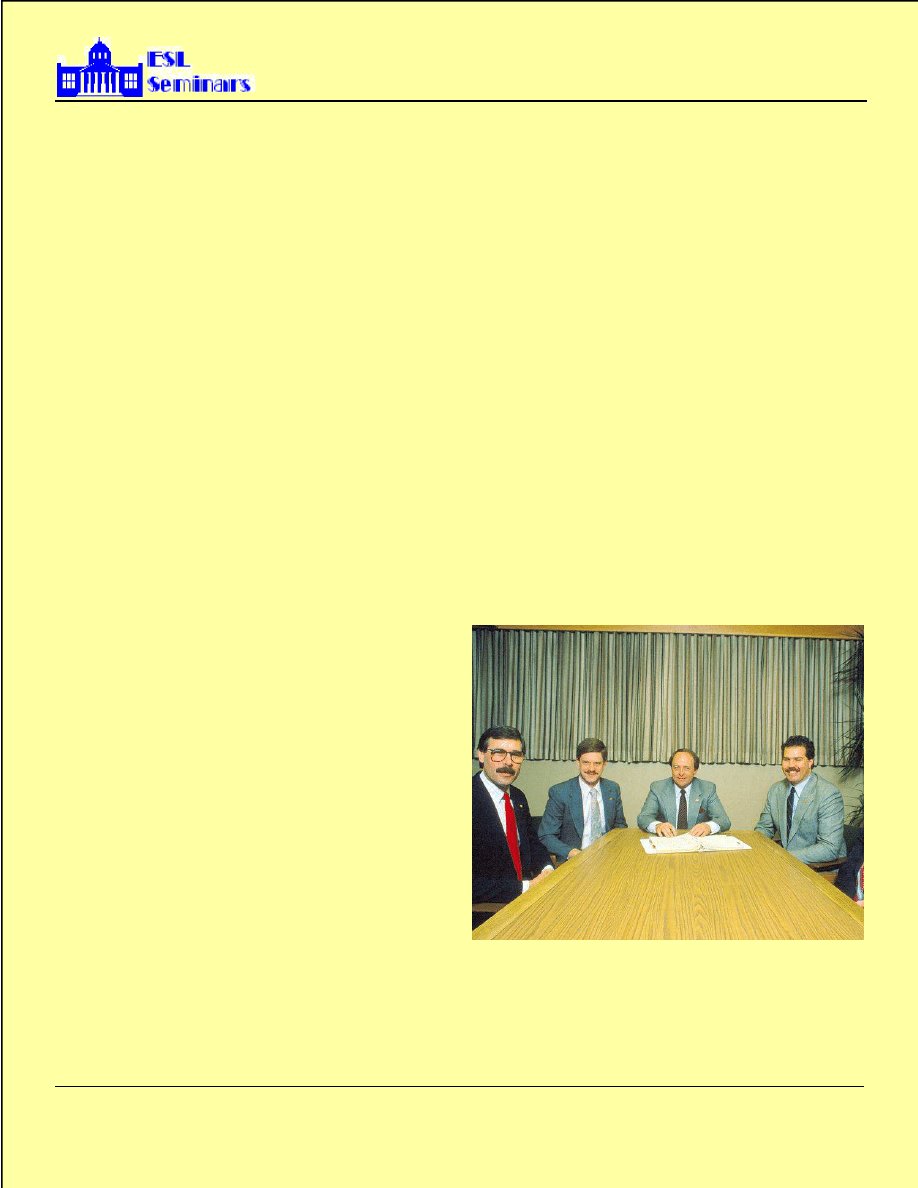
47
© 2003
ESL Seminars™
. All Rights reserved. No part of any
ESL Seminars™
material may be copied without express written authorization by
ESL
Seminars™
officials.
ESL Seminars™
are not affiliated with Educational Testing Service® (ETS®) and are not endorsed by them.
ESL Seminars™
offers no guarantees with it’s materials.
give both the positive and negative aspects of each one.
If you complete this task correctly, you will be giving
four different opinions. The positive side of newspa-
pers, the negative side of newspapers, the positive side
of television, and the negative side of television. The
question deals exclusively with newspapers and televi-
sion, nothing else. It would be advisable to compare
the two also.
Giving Your Opinion
It has been said that the measure of superior intellect is
the ability to hold two opposing views, or opinions, at
one time in one’s mind. This is your opportunity to
demonstrate that ability. The task is to tell the positive
and negative aspects of zoos. You must abandon any
personal views you have about this topic to enable you
to speak effectively and equally to each side of the top-
ic. Make sure you form your responses as arguments
for and against. It is this requirement for making an ar-
gument that requires you to abandon your personal
feelings in order to give equal treatment and time to
each side.
Defining A Technical Term
In Your Field Of Study
For this task it is imperative that you begin by mention-
ing just what your field of study is. If you are a nurse,
say so. If you are a teacher, say so. Whatever your ed-
ucation major is, you must state it. Then go on to tell
the technical term and explain it fully and carefully.
This is one answer that you should devote a lot of time
to in developing answers. Do not memorize! But you
should practice what your response is going to be and
you should pre-select your term well in advance of tak-
ing the TSE® exam.
Describe A Graph And
Speculate On The Implications
You will be shown a line graph (it might also be a bar
graph, etc.) with a timeline and increasing values. It is
standard graphing of past and assumed future events. It
is an absolute must that you understand how graphs are
constructed and how to read the information they con-
tain. It is beyond the scope of intent in this web site to
educate you in graph construction and interpretation. It
is your responsibility to obtain this skill or knowledge.
Giving Details Of An Upcoming Trip
And Making Changes To Those Details
For this task you will be presented a printed schedule
of an upcoming trip. There will be notations on that
schedule showing changes. It is your job to communi-
cate verbally what those changes are. In this case, you
should absolutely not read the material in a matter-of-
fact manner but you must present it as if you were
speaking to a large group of people. Imagine you are at
a podium facing a crowd. You must speak directly and
decisively.
Our Board of Directors

48
© 2003
ESL Seminars™
. All Rights reserved. No part of any
ESL Seminars™
material may be copied without express written authorization by
ESL
Seminars™
officials.
ESL Seminars™
are not affiliated with Educational Testing Service® (ETS®) and are not endorsed by them.
ESL Seminars™
offers no guarantees with it’s materials.
Elaborate “Strategies” And
Other Absolute Nonsense!
We have just finished reviewing some of the materials
given out by our other competitors. We respect their
efforts and their dedication to service. We are sure that
they have good intentions and good hearts.
With that being said, what they are giving their clients
and students is just a bunch of garbage! Excuse us for
being so blunt, but it is pure garbage! Each and every
one of them concentrate solely (SOLELY!) on
“strategies” of how to answer the “very complicated”
TSE® exam questions. Not one of them deals with
being understood and speaking with the correct pro-
nunciation, diction, etc. NOT ONE!
All of us here at
ESL Seminars
operate on certain
basic truths in regard to our clients. Please read these
carefully:
1. You are a college graduate.
2. Your college degree certifies that you have superior
intelligence.
3. Your college degree gives you the ability to solve
problems.
4. Your college degree proves that you can understand
very elementary situations.
5. Your college degree shows that you have an analyt-
ical mind and can mentally reduce problems and situa-
tions to their lowest common denominator.
What all that means is that we believe, based on your
college degree, that you can read a comic book, that
you can tell which way is up, which way is down, you
know your left from your right, and that you have the
ability to speak, and that you can tell time. If you have
passed the TOEFL we further believe you know how
to understand the English language.
This really isn’t so complicated. The primary problem
is in how you speak the English language!
If you have taken any kind of TSE® exam “refresher”
or “reviewer” in your respective country you have
probably been lead off in the wrong direction! You
need our help and you need it fast! Go back to the
page and read every single page of this web
site! Then order our “Kit” or register for a seminar!
Don’t fail the TSE® (or worse yet, fail again)!
OK, so now it’s time for our “duck” lesson again:
A duck could probably teach a chicken to quack like a
duck, but a chicken will never be able to teach another
chicken how to quack like a duck.
If that is a little too oblique for you to understand, let
me put into more common terms. A Filipino cannot
teach another Filipino how to speak English like an
American. An Indian cannot teach another Indian how
to speak English like an American. There is no refer-
ence point for them. It will still sound like Filipino-
English or Indian-English – and that will not give you
or anyone a passing grade on the TSE® exam! What is
needed is an American to teach American-style Eng-
lish.
It is just that simple!

49
© 2003
ESL Seminars™
. All Rights reserved. No part of any
ESL Seminars™
material may be copied without express written authorization by
ESL
Seminars™
officials.
ESL Seminars™
are not affiliated with Educational Testing Service® (ETS®) and are not endorsed by them.
ESL Seminars™
offers no guarantees with it’s materials.
Some Internet Places
You Might Consider
Visiting Soon
The following are Internet web pages that might have
some interest for you. We have added them to give you
the opportunity of building your knowledge on the
foundation you received in these pages and from our
audio CD’s.
Adobe Acrobat® Reader
http://www.adobe.com/products/acrobat/readstep2.html
This is the download page for Adobe Acrobat®. It is
free and it is the industry standard!
Adobe Systems Incorporated
http://www.adobe.com/main.html
Adobe’s main page.
TheFreeSite
Great free stuff like fonts, games, graphics, e-mail
service, chat programs, screen savers, etc.
MSN Hotmail
Free e-mail and other great stuff.
Dave’s ESL Cafe
Links to jobs, ESL exercises, resources, etc.
Randall’s ESL Cyber Listening Lab
Listening practice for students, improve your compre-
hension skills, etc.
ESL Self-Quizzes
http://www.aitech.ac.jp/~iteslj/quizzes/
Over 1,000 self-study ESL quizzes.

50
© 2003
ESL Seminars™
. All Rights reserved. No part of any
ESL Seminars™
material may be copied without express written authorization by
ESL
Seminars™
officials.
ESL Seminars™
are not affiliated with Educational Testing Service® (ETS®) and are not endorsed by them.
ESL Seminars™
offers no guarantees with it’s materials.
Consider Your Fortunes,
Then Consider Giving
To Those Less Fortunate
Of the many things we have learned in our collective
lifetimes, one of the most important is to give back
some of what we gain. Give it back to those less
fortunate, to those who are facing the bleakest of
futures that a human being can face.
There are children in this world, especially in the
Philippines, that are born with serious physical afflic-
tions. Most of these children are born to those in the
depths of poverty, unable to help themselves or their
unfortunate children.
What can you do? You can contribute, even if just a
little. If you have only a dollar in your pocket, consider
giving a penny. If all you have is a peso, consider
giving just one centavo.
San Pedro Hospital has made it their 60-plus year
commitment to helping the poor. According to the
Alexian Brothers, a Roman Catholic Congregation, the
Dominican Sisters of Trinity at San Pedro Convent/
Hospital have done some stunning work for the poor.
During the early 1990's, the Brothers began working
with San Pedro Hospital in Davao, acquiring equip-
ment from the Alexian Brothers' hospitals in the
United States. The 220-bed facility served the very
poor of the city, with a full sixty percent of its patients
being charity cases. The donated equipment helped the
hospital to develop some profitable departments but
the mission has been, and still remains, assisting the
poor.
As another part of their charitable work, the Domini-
can Sisters of Trinity have created a Community Ex-
tension Service (CES). The CES serves the poor
fisher-folk of Isla Suerte, the poor patients of San
Pedro Hospital, and many children of poor parents
living in and around Davao.
The CES currently has 287 pre-school-age children
that they are educating for free! The tuition for these
children is only 50 pesos (one small dollar)! Can you
imagine that! Only one dollar
per month! Even at that ex-
tremely
low
tuition
the
children’s parents cannot af-
ford to pay, since it would be
taken from the only money
they have for rice and dried fish.
In addition to helping the chil-
dren of the poor, the Domini-
can Sisters of Trinity have
developed a program to assist those who cannot afford
to pay for college. Currently they are assisting those
who are studying to obtain a one-year college certifi-
cate, such as Health Care Givers and Health Care
Aides. With your help they can expand this program to
full four-year degree programs.
Why is this so important? Because educating the poor
will help them rise up out of the poverty by obtaining
good-paying employment. This is not done by hand-
outs. The good Sisters know that very well. It is done
by subsidizing sound, practical, education. The prov-
erb of: “Give a person a fish and they eat for today.
Teach them to fish and they can feed themselves for a
lifetime.” is well understood by the Dominican order
of nuns. That is why they have dedicated themselves
to not only healing the bodies of the poor but also to
educate their minds so they can shed the shackles of
poverty.
Won’t you help? Can you afford the price of a stick of
gum? The price of a soft drink? One hour’s salary from
a monthly paycheck?
Send whatever you can (by check, money order, etc.)
to:
San Pedro Hospital CES,
12 C. Guzman Street (Dept. SRE)
Davao City, 8000
Philippines.

ESL
Seminars
ESL Seminars is not affiliated with, nor is it endorsed by, the Educational Testing Service®, creators and
administrators of the Test of Spoken English® exam. All material contained within this booklet, with the exception of
the sample questions provided by Educational Testing Service®, is the product of the creative minds of
ESL
Seminars staff. This material is presented as a guide to effectively prepare non-native English speakers to pass
entrance exams as part of a visa screening process. This material is primarily intended to be used as a class guide in
conjunction with
ESL Seminars’ Interactive Participation™ techniques.
Wyszukiwarka
Podobne podstrony:
Validation of a test battery for the selection of call centre operators in a communications company
(ebook english) TOEFL Preparing Students for the Computer Based Test
The American Society for the Prevention of Cruelty
[Pargament & Mahoney] Sacred matters Sanctification as a vital topic for the psychology of religion
International Convention for the Safety of Life at Sea
Broad; Arguments for the Existence of God(1)
Kinesio taping compared to physical therapy modalities for the treatment of shoulder impingement syn
GB1008594A process for the production of amines tryptophan tryptamine
Popper Two Autonomous Axiom Systems for the Calculus of Probabilities
Anatomical evidence for the antiquity of human footwear use
The Reasons for the?ll of SocialismCommunism in Russia
APA practice guideline for the treatment of patients with Borderline Personality Disorder
Criteria for the description of sounds
Evolution in Brownian space a model for the origin of the bacterial flagellum N J Mtzke
Hutter, Crisp Implications of Cognitive Busyness for the Perception of Category Conjunctions
Apparatus for the Disposal of Waste Gases Disposal Baphomet sm
An Argument for the Legalization of Drugs
więcej podobnych podstron